DECOPLANNER
Past, present, and future of GUE’s decompression planning tool
THE MESOPHOTIC ZONE
Deep conservation project in the marine forest of Portofino
PHOTOGRAPHER
BECKYPORTFOLIO:KAGAN SCHOTT
OX BEL HA EXPLORATION
Still searching for the elusive connection to the Caribbean
COMPUTERS & TIMERS
The reliability of modern digital dive instruments has improved

Vol. 24, No. 1 – February 2023 EDUCATION · CONSERVATION · EXPLORATION · COMMUNITY The
Journal of Global Underwater Explorers Quest

Don’t be a missionary!
I’vebeen diving for over 30 years, and needless to say, my equipment and diving style has undergone more than a few changes since my days as a beginner. Back then, I was the prototypical recreational diver with a bulky jacket-style BCD, a regulator setup with hoses all over the place, double 7mm wetsuits or even thicker neoprene drysuits, and a giant rubber console with analog instruments. Slowly, I gravitated toward a more streamlined and simplistic configuration. But I needed to make these changes gradually, and it took me a few years to fully embrace the DIR/ GUE philosophy.
If anyone had preached or lectured me about the blessings of the backplate or the safety benefits of a team-based approach during my journey toward a minimalistic and standardized configuration, I would not have appreciated their condescension toward me. I needed to discover those advantages on my own. All this took place before I finally enrolled in my first GUE class.
Today, were I to meet my younger self, I hope it would be with an inclusive attitude. I also hope I would recognize the young Jesper’s equipment configuration and diving style choices made perfect sense to him at the time and that it was all good as long as he was safe and had fun.
First and foremost, let’s celebrate all divers. They share our passion and enthusiasm for exploring the underwater world. Even if they embrace a different diving approach, they have chosen to engage in diving activities instead of the numerous other hobbies that compete with diving. It would be unfortunate if they were to meet overbearing missionaries with a patronizing, know-it-all attitude. After all, they just might
leave diving in favor of other pursuits with more approachable and welcoming communities.
But of course, if anyone seems interested in how you configure your equipment or approach dive planning, that is your opportunity to share information on our diving approach. Even better, if they see you in the water and notice your trim and level of control, you have an excellent opening to explain what GUE is all about and how you developed your diving skills to that level.
We know that actions speak louder than words, so giving interested divers a chance to experience how a GUE team executes a dive will have a lot more impact than the missionary approach. One successful back-kick may be all you need to convince the skeptics!


Dive safe and have fun!
Jesper Kjøller Editor-in-Chief jk@gue.com
3 February 2023 · Quest EDITOR’S LETTER
Editor-in-chief
// Jesper Kjøller
Editorial panel
// Michael Menduno
// Amanda White
Design and layout
// Jesper Kjøller
Copy editing
// Pat Jablonski
// Kady Smith
Writers
// Nils Lucas Jacobsen
// Brad Beskin
// Bjarne Knudsen
// Emőke Wagner
// László Cseh
// Andreas Hagberg
// Kirill Egorov
// Dan Mackay
// Daniel Riordan
// Fred Devos
// Todd Kincaid
// Chris Le Maillot
// Jarrod Jablonski
// Dimitrios Fifis
Photographers
// Becky Kagan Schott
// Kirill Egorov
// Claudio Provenzani
// Andreas Hagberg
// SJ Alice Bennett
// Julian Műhlenhaus
// Derk Remmers
// Alfonso Sabella
// NiccolÒ Crespi
// Tom St George
IN THIS ISSUE
6 10 22 36 42 52
QC CORNER // DREAD OR DELIGHT
Your most important piece of equipment is your brain and its ability to calculate deco, assess and remedy failures, and make you a part of a truly unified team.
THE MESOPHOTIC ZONE
Nils completed his master’s thesis in marine biology, investigating the effects of marine animal forests (MAFs) on the underlying benthic community in the upper mesophotic zone. For two months, he and his team collected photographic samples in the beautiful marine protected area of Portofino, Italy.
OX BEL HA // EXPLORATION CONTINUES
The number of new caves exemplifies the extent and complexity.The potential of finding something new drives the small team to improve their skills, procedures, and equipment according to the different challenges they encounter in each section of the caves.
PORTFOLIO // BECKY KAGAN SCHOTT
She believes the biggest secret to successful underwater photography is passion. When shooting something she is interested in and feels inspired by, she believes that it shines through in the imagery.
DECOPLANNER
DecoPlanner has long been the tool that has formed the basis of most decompression schedules used by GUE students. Andreas Hagberg looks at where it all started, what the current state is, and where DecoPlanner might be heading in the future.
CAVE // NAVIGATION & TECHNIQUE
Going into a cave lacking solid navigation skills and proper diving techniques can quickly change the situation from benign to dangerous. We review cave navigation protocols and define what we mean when we talk about good technique in cave diving.
COMPUTERS AND TIMERS
The technical capacity and reliability of dive computers have greatly improved, and today’s decompression computers can very closely approximate current GUE diving protocols.
4 Quest· February 2023
Vol. 24, No. 1 · February 2023 Quest is published quarterly by Global Underwater Explorers 18487 High Springs Main Street, High Springs, Florida 32643 www.GUE.com Follow Quest on Facebook www.facebook.com/QuestJournal The Journal of Global Underwater Explorers Quest 62


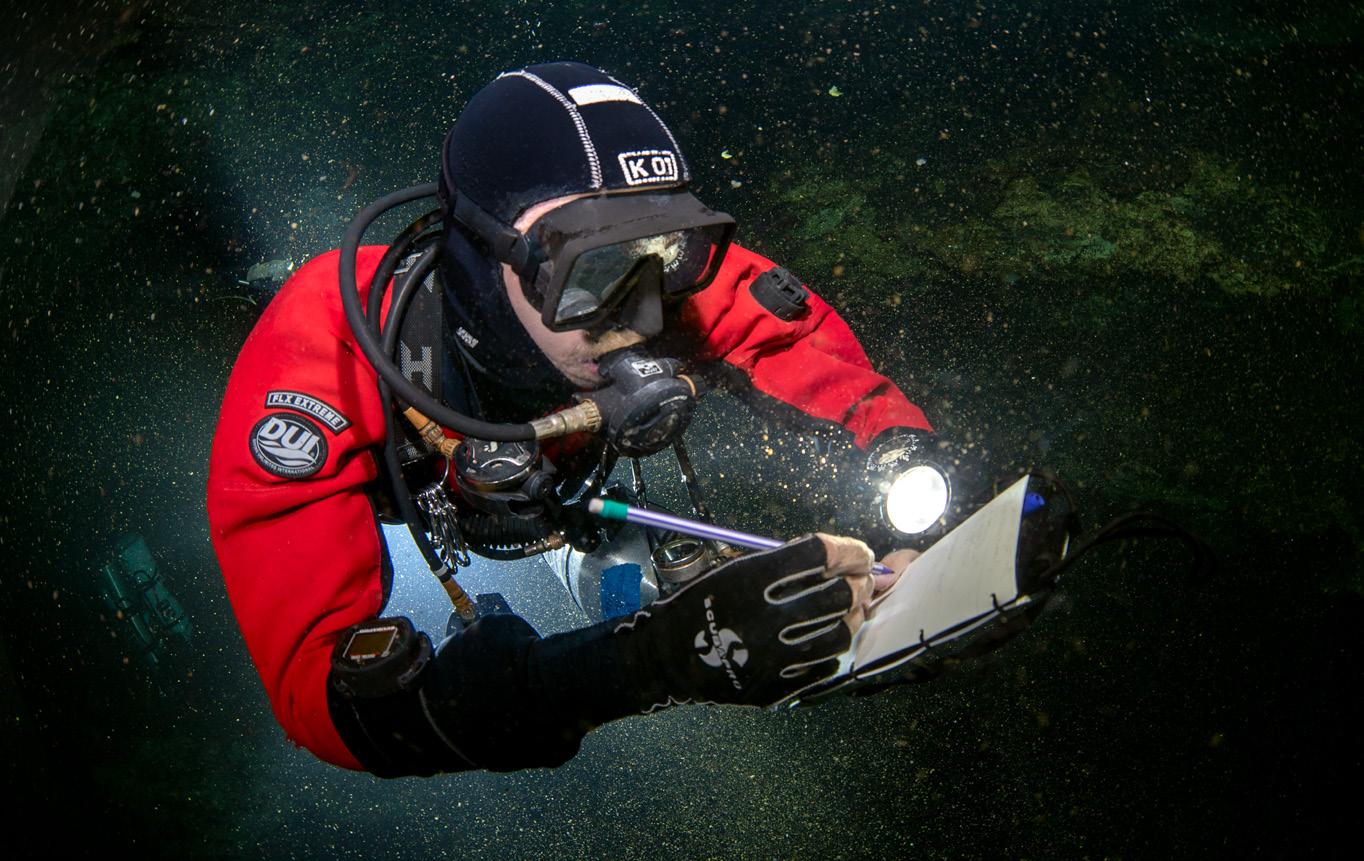
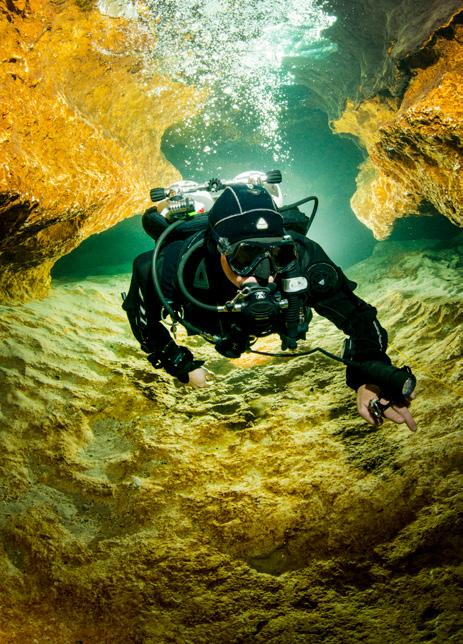
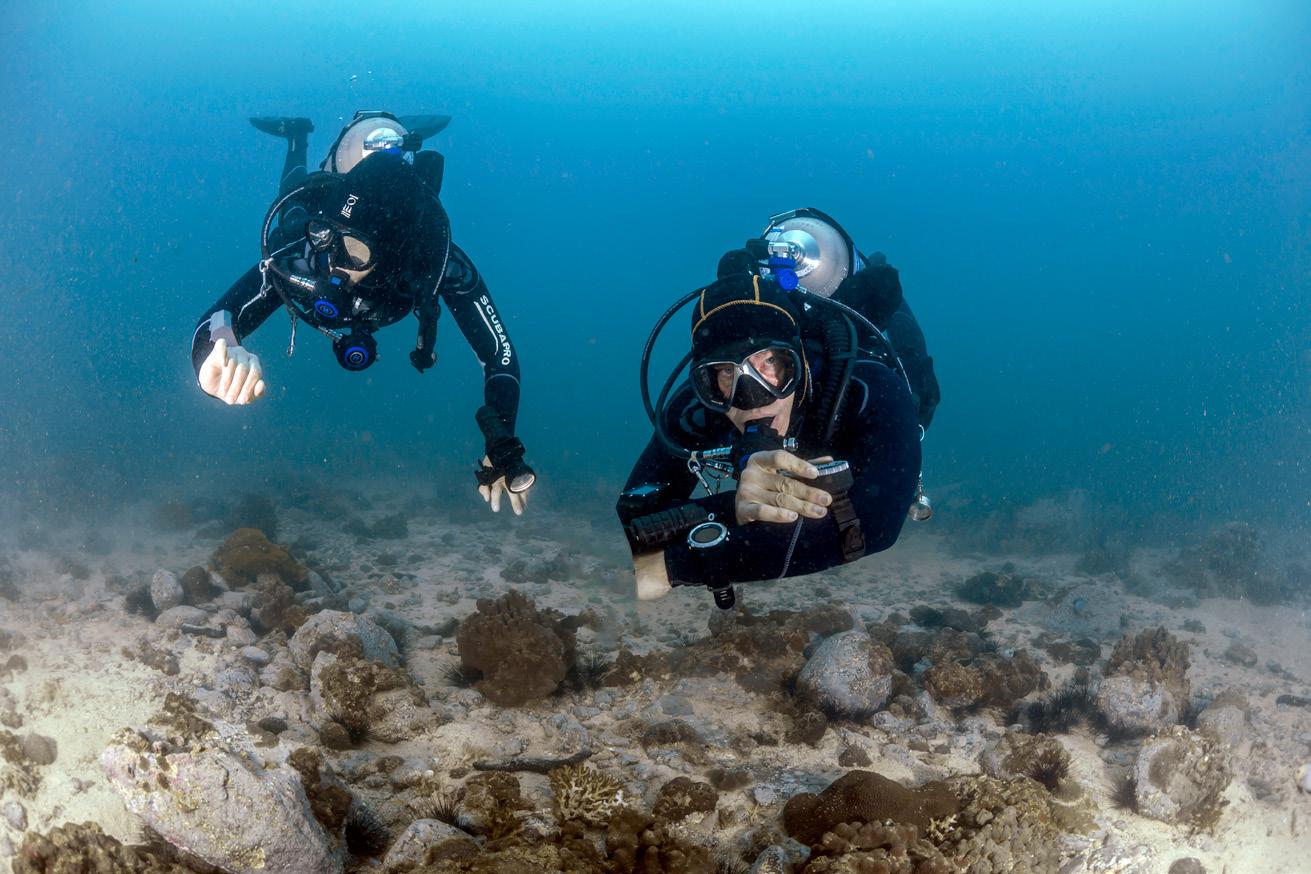
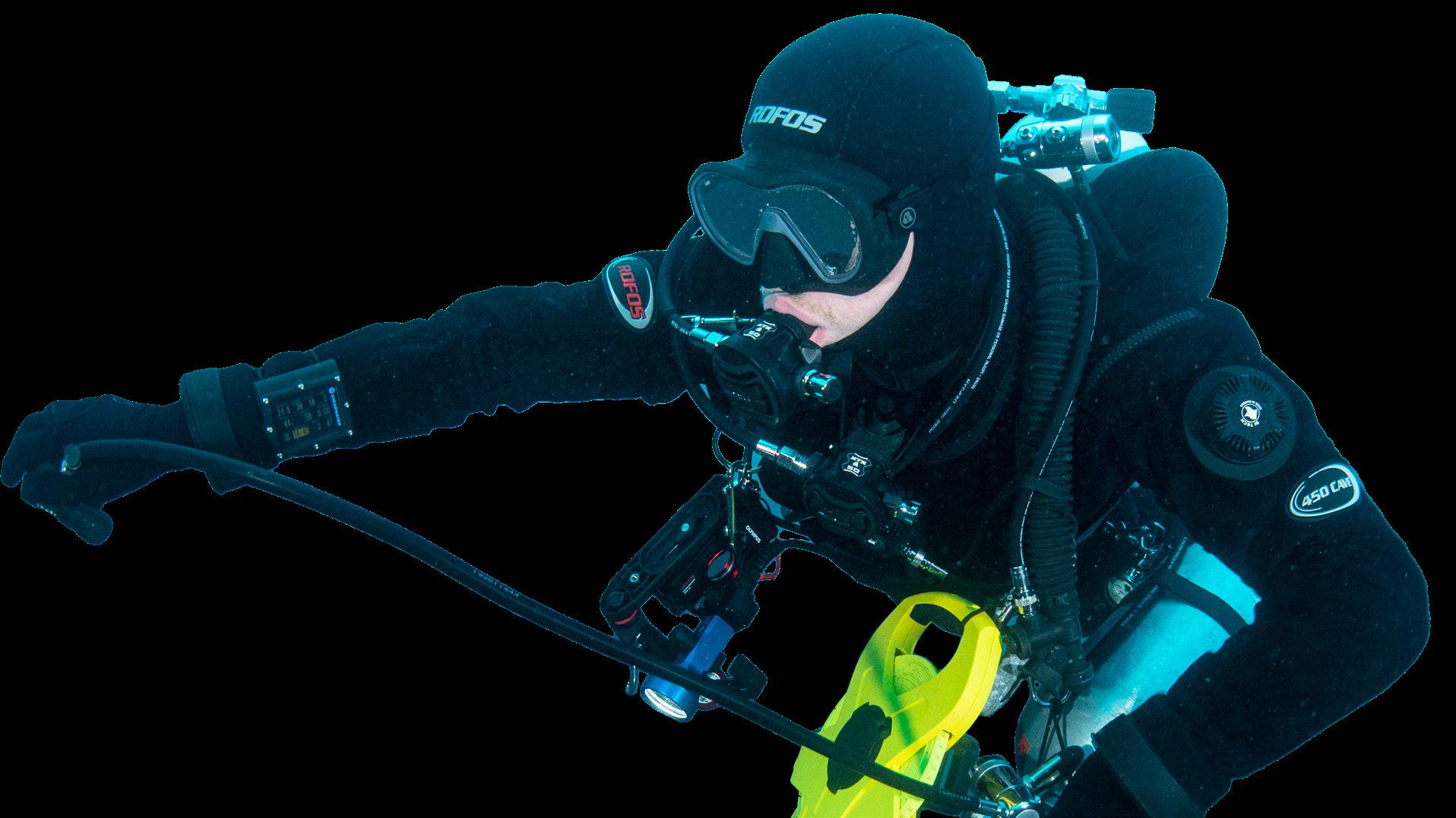


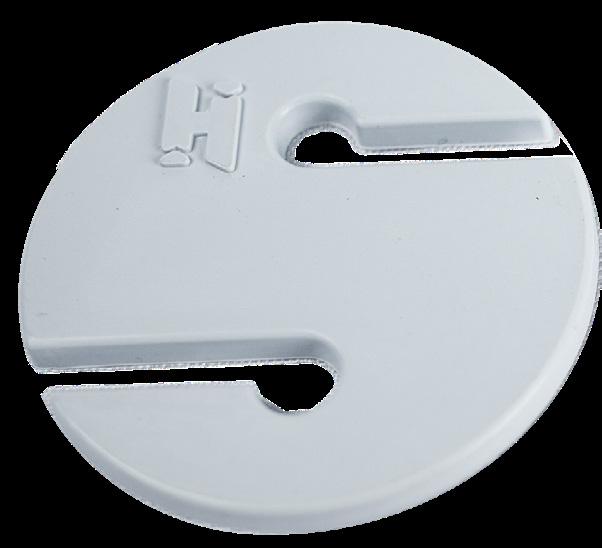

5 February 2023 · Quest
22 10 62 42 52 6
COVER PHOTO BECKY KAGAN SCHOTT
QC CORNER
DREAD AND DELIGHT
CONFRONTING THE “EEKS” IN ADVANCED DIVING
Brad Beskin feels at home in caves but addresses the need to understand and recognize fear as a human reaction to unusual circumstances.
 TEXT BRAD BESKIN
PHOTO SJ ALICE BENNETT
TEXT BRAD BESKIN
PHOTO SJ ALICE BENNETT
6 Quest· February 2023
Our brain can often be our worst enemy; it regularly pits logic against emotion in a convoluted and confusing barrage of mixed signals. And diving presents many opportunities for battles between anxiety and excitement, fear and elation, dread and delight.
Despite the depth of training and experience GUE divers obtain, few are immune from the occasional recognition they—cruising beneath the waves—are not supposed to be there. At some point, most technical and overhead divers will encounter the sense of discomfort that often accompanies this realization. Whether this manifests in a sense of unease, dread, or fully fledged panic, what we commonly call “fear” is a mental and physiological risk we must address.
However, I am more concerned in this column with the risk posed by the societal pressure to bury the sensation, ignore it, or even explain it away. In addressing this subject, The New York Times cited Leon Hoffman, co-director of the Pacella Research Center in New York: “Our culture valorizes strength and power and showing fear is considered weakness. But you are actually stronger if you can acknowledge fear.” Murphy, Outsmarting Our Primitive Response to Fear, The New York Times (Oct. 26, 2017). So, to that end, let us talk about fear.
The “eeks”
Admittedly, this sensation is familiar to me. Despite more than 28 years of diving experience and many, many overhead dives, I still get what many cave explorers call the “eeks” from time to time. I have, on occasion, been quick to dismiss them: “it’s not that I’m afraid…must have been CO2…everything was fine.”
In reality, something in my brain triggers the need to question—honestly, directly, and involuntarily—whether I truly want to be on that dive at that moment. My vision narrows, my breathing increases, and my mind wanders down an irrational and unwarranted slippery slope of horribles.
The solution is straightforward: I know the symptoms and can see them coming from the first hair that raises on the back of my neck. Stop, stabilize, signal. Wait. Breathe. Check gas and flow check. Wait. Breathe. In approximately 30-60 seconds, all is right. Rational thought returns; remaining dread dissolves to delight, and the dive continues.
Why does this happen? I am literally writing this in an office surrounded by pictures of cave diving—both of my heroes and of me—thinking of how I can squeeze in another trip to High Springs or Mexico in short order. I don’t consider myself to be afraid of diving—even the overhead or technical sort. Yet, dread and I have become casually acquainted as I extend my limits. Why?
7 February 2023 · Quest
In this, my second opportunity to bend your ear as GUE’s Director of Quality Control, I would like to talk about equipment. No, not your CCR or your DPV, but rather the most important piece of equipment you own: your brain—that complex, spongy mass between your ears that can calculate deco, assesses and remedies failures, and makes you a part of a truly unified team.
Brain matter matters
Physiologically (and this is admittedly a reductive take), my amygdalae appear to be the culprits: those almond-shaped structures in my cerebral hemispheres, which are considered to be the root of what we identify as fear (the involuntary and often irrational kind of fear). The amygdalae principally define and regulate emotions. They also preserve memories and attach those memories to specific emotions (e.g., happiness, sadness). These emotional remembrances are the reasons I feel anticipation when I hear my high school sports team’s warm-up song for the first time in years, or why my heart flutters when my nose is reminded of my grandma’s cooking.
The amygdalae are also responsible for our fight-or-flight response. The quickening pulse, clenching, pupil-dilating response is automated; it reacts before conscious processes (like logic) have a chance to come online. These reflexes have been tuned throughout evolution to keep us alive. They are, in a sense, a safety mechanism that overrides (or “hijacks”) the voluntary, rational, and analytic functions of the cerebral cortex. See Goleman, Emotional Intelligence: Why It Can Matter More Than IQ, Random House (2005).
In activating the fight-or-flight response, the body doses itself with chemicals like cortisol and adrenaline. Blood flow to muscles increases (assumedly, for strength or speed); the airways expand to increase oxygen to the blood; blood sugar increases to provide you immediate energy; and pupils dilate. Respiration and heart rate increases. Perspiration sets in. The mind grasps for information, and the response thereto is often out of sync with reality.
Of course, not everyone experiences fear the same way. “The complex neurological and ecological foundations of our fear perceptions and responses means a continuum exists whereby fear for one person may insight bravery and courage, and for another fear may insight terror and vulnerability.” Reed and Smith (2021). And each individual’s response is geared to specific stimuli (e.g., small, confined, dark, and labyrinthine spaces).
We must also acknowledge competing chemical realities. Advanced diving requires the assumption of certain risks. Some risk takers’
brains may be naturally lower in levels of dopamine and/or serotonin (see Manly, What Makes Risk Takers Tempt Fate?, National Geographic (Aug. 15, 2016))—important neurotransmitter regulators of the brain’s reward and pleasure centers, as well as its physical and emotional responses.
What matters here is the fact that certain sensations of fear (and our physiological responses to them) are directly attributable to involuntary responses to stimuli. They are natural, beyond our control, and invariably human.
I suppose this raises the question: Why would we engage in an activity that involves fear? But each of us understands why we might risk an encounter with dread. Pat Jablonski wrote a compelling piece in InDepth’s October 2022 release addressing specific motivations underlying risk-taking in extreme sports like ours. She said, “diving forces divers to pay complete attention to a task, to focus with laser-like precision in order to conquer misgivings, and to attain a skill that few others have. Confidence comes with accomplishment. Leadership emerges. Fear is overcome.”
She’s right; there is nothing akin to the sense of accomplishment that comes with completion of a challenging dive, and I venture many of us undertake advanced dive training to, at least in part, prove to ourselves we can do it. Whether we overcome our fears or merely learn to manage them is the question; our fears likely remain an integral part of many of us. And, of course, a healthy dose of fear may raise awareness and ensure thorough preparation; why else would we religiously analyze gas and adhere to standards?
Talking about Fear
It is essential that those of us who encounter the “eeks” talk about it with our teammates and peers. “Sharing negative emotions can lessen their impact [..], build empathy[…], encourage others to open up about their own negative emotions, and help others recontextualize and overcome those struggles — ultimately boosting morale and performance…” Howe, Menges, and Monks, Leaders, Don’t Be Afraid to Talk About Your Fears and Anxieties, Harvard Bus. Rev. (Apr. 18, 2021).
8 Quest· February 2023
The alternative is untenable. “The more you try to suppress fear, either by ignoring it or doing something else to displace it, the more you will actually experience it.” Murphy, supra (citing Prof. Kristy Dalrymple, Alpert Medical School of Brown University).
Nevertheless, there is a taboo surrounding the discussion of emotions, and this permeates high risk activities and environments in a detrimental way. Cultural pressures often dictate that “[a]dults are supposed to control their intense emotions” and “fear is supposed to be curtailed”; these pressures have made the curtailing of fear an “automatic response” to avoid demonstrations of behaviors that might be viewed as “embarrassing” or “aberrant.” See Brymer and Schweizer, Extreme Sports Are Good for Your Health, J. of Health Psy (2013). For males, this can translate into symptoms akin to “toxic masculinity”—wherein somehow the acknowledgment of emotion weakens virility. This fallacy may also dictate the avoidance of emotion for women because high risk activities have no room for “weakness.” This is, of course, arcane and absurd.
Nevertheless, this fallacy (that emotion is somehow equated to weakness) is widely reinforced (at least in the United States) by societal attitudes, which makes it a reality many confront daily. For example, a recent survey by the Pew Research Center found respondents attributed protective behavior as a positive trait for men, while being emotional was viewed negatively. See Walker, Bialik, and van Kessel, Strong
Men, Caring Women, Pew Research Center (July 24, 2018).
Let’s change that. Let’s talk about fear…the “eeks”…the dread that creeps into our delight. In April 2022, a friend of mine—an experienced diver and instructor in Mexico—wrote a social media post about this topic and his own unexpected encounter with dread. He focused on the importance of human connection—the ability of simple eye contact or a reassuring touch to thwart an amygdala hijack. The response to his post inspired this column: dozens of comments reflecting appreciation for acknowledging this reality, personal stories of similar experience, and a shared acknowledgement of this ever-so-human condition. These came from divers all over the world-renowned explorers and amateurs alike.
The message is clear: each of us is human. We are the product of ability and limitation, strength and weakness, amygdala and cortex. We deserve healthy discussion and acknowledgement, both in ourselves and from our peers, of each side of this equation.
Have you encountered the “eeks”? How did you respond—not in the moment, but once the truck was packed and the dive gear put away? I hope you talked about it (and if you didn’t, I hope you will do so next time). On the other hand, can your teammates approach you to talk about their experiences? Do you create a culture of taboo on your team, or do you acknowledge your teammates are human—a product of their dread and delight.
Brad Beskin has been diving actively for approximately twenty-eight years. He first became involved with GUE by taking Fundamentals in 2002, and then Cave 1 with Tamara Kendal in 2003. He is now a proud GUE DPV Cave diver and is looking forward to undertaking
the GUE technical curriculum in 2023. When he is not diving, he earn his living as a civil litigator in Austin, Texas, and he also finds time to act as Director of Quality Control and the Chair of the Quality Control Board for Global Underwater Explorers.

9 February 2023 · Quest
Brad Beskin
STUDYING THE MESOPHOTIC
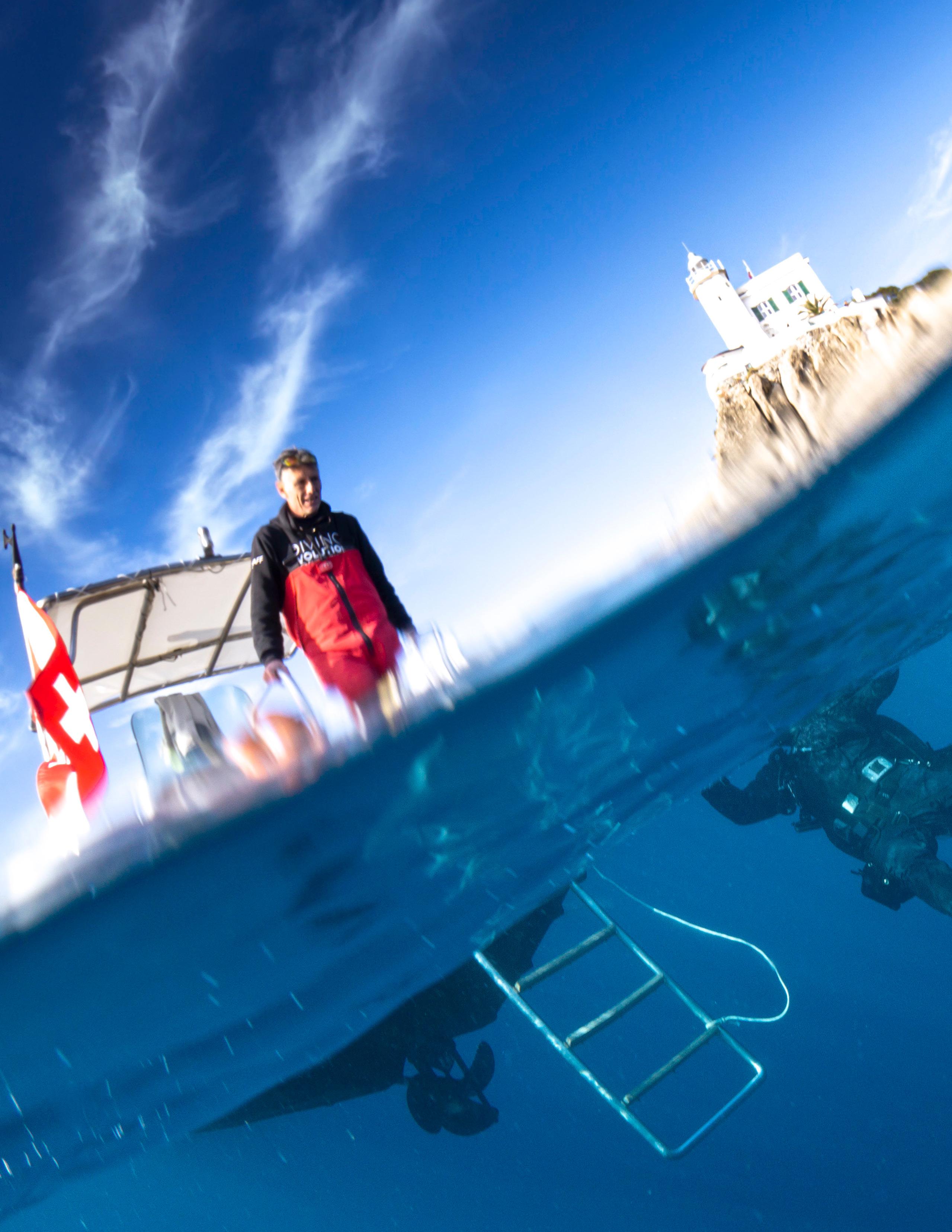
– A world between worlds
TEXT NILS LUCAS JACOBSEN
10 Quest· February 2023
PHOTOS ALFONSO SABELLA & NICCOLÒ CRESPI
THE MESOPHOTIC ZONE
Nils Lucas Jacobsen completed his master’s thesis in marine biology, investigating the effects of marine animal forests (MAFs) on the underlying benthic community in the upper mesophotic zone. For two months, he and his team collected photographic samples in the beautiful marine protected area (MPA) of Portofino, Italy. His GUE Tech 1 and GUE Scientific Diver certifications proved to be invaluable tools in his research.
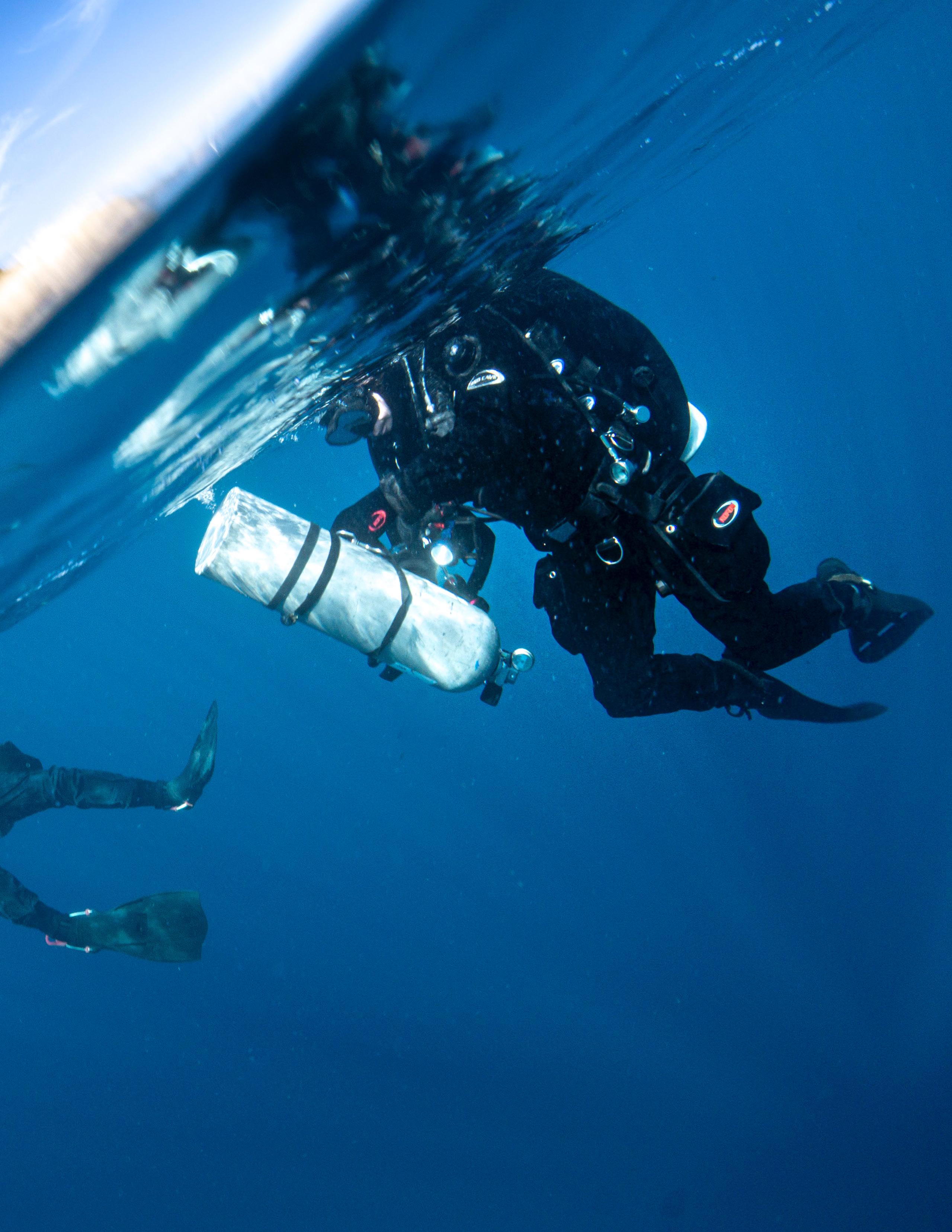
PHOTO NICCOLÒ
CRESPI
11 February 2023 · Quest
Portofino is characterized by rich and diverse fauna and flora, making decompression stops after sample collection highly rewarding.

12 Quest· February 2023
Getting cooked in my drysuit and carrying so much gear that I look like a swimming Christmas tree can only mean one thing: We are going for another scientific dive!
Getting here took multiple months spent writing research proposals and planning logistics. A big part of the preparation was honing my diving skills and acquiring the necessary certificates. When I was first inspired to complete the project, I was an advanced open water diver and far from able to perform scientific work underwater. Coming from a different diving organization, I completed the GUE Fundamentals course first. It was a real game-changer for me and provided the solid foundation that I needed for my future endeavors.
In 2021, I completed the Scientific Diver course, gaining the skills and confidence to start my journey as a scientific diver. The courses were demanding, but also thorough, and incredibly valuable to me not only as a diver, but also as a marine researcher.
To work in the upper mesophotic (40-60 m/130-200 ft) zone, I needed to go further—or, rather, deeper—so I set my sights on GUE’s Tech 1 course. As my skills did not yet meet the high standards demanded by technical diving, I practiced my buoyancy, my kicks, and GUE’s standard operating procedures many times during a “training camp” in Sagres, Portugal. Finally, I reached my goal—the technical pass. The Tech 1 course was an incredible experience. My instructor and my team were wonderful. Together, we faced many challenges, simulated various failures, dived in low visibility, and explored the historic wrecks of the Adriatic Sea. GUE’s courses gave me the necessary skill set to perform scientific work underwater and opened a new world of exciting technical scientific diving.
The mesophotic zone
In scientific literature, the mesophotic zone has most often been described as the area between 40-120 m/130-400 ft. These limits are based on convention and do not necessarily reflect a change in biological parameters. Therefore, a more meaningful and unambiguous definition has been introduced for the Mediterranean me-

“
In scientific literature, the mesophotic zone has most often been described as the area between 40-120 m/130-400 ft.
13 February 2023 · Quest
PHOTO NICCOLÒ CRESPI

14 Quest· February 2023
PHOTO ALFONSO SABELLA
world of exciting technical scientific diving.
The good visibility and, for winter time, relatively warm water temperatures make for an amazing workplace underwater.

15 February 2023 · Quest
“GUE’s courses gave me the necessary skill set to perform scientific work underwater and opened a new
sophotic zone: as the upper limit, the depth at which 1% of the surface irradiance arrives, and as the lower limit, the deepest depth at which primary producers can be found. As a result, the mesophotic zone is placed between the light-intense euphotic zone (where light is sufficient for the growth of plants) and the dark aphotic zone (with little or no sunlight).
Now that we have the definition out of the way, what is so important about this zone?
It is no secret that coral reefs are in decline worldwide. This decline results from a combination of global and local stressors such as overfishing, storm damage, sedimentation, eutrophication, toxic discharge, disease, ocean acidification, and thermal stress. These factors are believed to be less impactful at deeper depths, not (or only partially) affecting mesophotic ecosystems. Furthermore, mesophotic ecosystems are less exposed to thermal anomalies and the related mass-mortality events that are occurring in the Mediterranean Sea, especially during recent decades.
In theory, the mesophotic zone could serve as an important refugium for organisms escaping unfavorable conditions in the upper water layers and could replenish shallower reefs by providing a nursery ground for larvae and juveniles. These functions are highly debated and urgently require more scientific attention. Moreover, there is information about impacts on mesophotic ecosystems that has been reported, particularly regarding physical damage from hurricanes, impacts of fishing activities, sedimentation, coral bleaching, and invasive species. In contrast, undiscovered, pristine ecosystems characterized by minimal human pressure could serve as a valuable baseline against which we can compare the status of threatened and degraded ecosystems. Therefore, the mesophotic zone may prove an important tool to fight the so-called “shifting baseline syndrome.”
Widely underexplored
But, mesophotic zone exploration is easier said than done. Due to its depth, accessing the mesophotic zone is costly and requires specialized equipment, training, and experience.
Recreational divers can usually reach a maximum depth of 40 m/130 ft, and beyond that, the realm of technical diving begins. Therefore, many studies focus on shallow-water habitats only.

Submersibles offer another option for the exploration of the mesophotic zone. They can reach deep depths and carry heavy equipment like high-resolution cameras. Due to their high operating cost, submersibles have mostly been used in deeper environments, leaving the mesophotic zone largely unexplored. However, in recent years, the scientific interest regarding this research area has been increasing thanks to the improvement (and the decrease in costs) of technologies such as autonomous underwater vehicles (AUVs) and remotely operated vehicles (ROVs).
The good news for all divers and curious people out there is that advanced scuba diving technologies—such as mixed gases (trimix) and closed-circuit rebreathers (CCRs)—make observations and physical experiments at mesophotic depths possible. Given the unmatched capability of direct observations and sample collection, scientific diving is a powerful tool that we should use to its fullest potential.
While the mesophotic zone remains widely underexplored, a number of studies have revealed high levels of habitat complexity and important species richness in both temperate and tropical environments. While data indicate diverse mesophotic ecosystems with high endemism, the underlying processes have not been clearly identified. Nonetheless, these characteristics may be attributed to the high environmental stability over glacial sea level changes, as well as the restricted dispersal at deeper
PHOTO JONO ALLEN
16 Quest· February 2023

PHOTO NICCOLÒ CRESPI
17 February 2023 · Quest
The GUE gas switch procedure offers high safety and should be properly executed, even when diving with only one deco cylinder.
A beautiful Paramuricea clavata in the foreground as the measuring tape is carefully collected. The only thing we take is pictures and we leave nothing behind.
depths due to slower water movements. Both hypotheses (especially the latter) require more scientific attention to draw any conclusions. Earlier studies suggest that the upper mesophotic zone especially (<60 m/200 ft) is inhabited by shallow-water species, as well as species from deeper waters, forming an important transition zone between the two, and possibly resulting in increased diversity levels.
Marine animal forests

At deeper depths, environmental parameters tend to be less variable than at shallower depths. This is especially beneficial for the slow-growing, long-lived species that can thrive and reach large sizes and densities there—the organisms that form the so-called marine animal forests (MAFs). Additionally, due to the lower light availability, fast-growing autotrophs tend to be less competitive, resulting in a higher success rate of others.
If you have ever stood in a terrestrial forest, you have experienced its influence on the surrounding environment. It provides shade, im-
portant habitats, and shelter (from high winds, for example). Similarly, MAFs can alter current velocity, light intensity, and sedimentation rates. They contribute greatly to the 3D complexity of the underwater world and have a positive effect on biodiversity by increasing the amount of available micro-habitats.
One of the most peculiar features in the MPA of Portofino is the beautiful gorgonian forests, mostly made up of the gorgonian Paramuricea clavata. Larger structures, such as the ones created by P. clavata, can offer protection from mechanical damage to the understory. It has been reported that colonies of this species are vulnerable to aggregations of mucilage, but at the same time may protect the organisms living below from suffocation by trapping those aggregations. Additionally, gorgonian forests can hinder the spread of invasive species.
Sadly, the ecologically valuable MAFs are facing multiple threats such as mechanical damage from lost fishing gear and recreational diving, the aggregation of mucilage (and the implications of this phenomenon), invasive spe-
18 Quest· February 2023
PHOTO NICCOLÒ CRESPI
cies, and increased sedimentation rates. Additionally, marine heatwaves are likely to increase with ongoing global climate change, and multiple mass mortality events of gorgonians—linked to high temperatures—have already been documented for the northwestern Mediterranean Sea. The loss of gorgonian forests could lead to major shifts in the associated benthic community and could result in lower diversity, as well as lower resistance against (and resilience to) disturbances.
The study
Mesophotic coral ecosystems (MCEs) represent an important but highly understudied research area. Without knowledge of the distribution and biomass of MCEs, their global role cannot be described, and therefore effective management and protection measures cannot be implemented, making the exploration of such ecosystems highly important.
To understand the functional role of MCEs and protect these valuable habitats, information about their community composition and structure is needed. Thus, the goal of our research was to study differences in epibenthic communities in relation to the density of forest-building species— in this study represented by Paramuricea clavata—at two different depths: 35 m/115 ft and 50 m/165 ft. To highlight the potential of Structure from Motion (SfM) photogrammetry, a 3D reconstruction of one of the analyzed forests was created, extracting the height frequencies of the gorgonian population from it.
In practice, we collected photographic samples at three different sites (two depth levels each) along the south coast of the Portofino promontory. During technical dives, we placed 30 m/100 ft transects on the seafloor and filmed the gorgonian forests as well as the understory. The dives were challenging but very rewarding. As a Tech 1 diver, I was limited to around 20 minutes of bottom time at the 50 m/165 ft level. That was barely enough time
to find a gorgonian forest, place the 30 m/100 ft transect, film the gorgonian forest from above, film the understory during a second pass, and collect the measuring tape. At the same time, it was incredibly important to swim very slowly and keep the camera steady. The margin for error was low, and finding the balance between working fast and swimming slowly wasn’t always easy.
The highest forest density that we observed was around five colonies per 1 m²/10 ft². In comparison, pristine gorgonian Paramuricea clavata forests can easily reach 20 colonies per 1 m²/10 ft² and sometimes even over 50 colonies per 1 m²/10 ft². Therefore, the maximum densities observed here are low compared to other areas. The frequent mass mortality events of gorgonians recorded in the northwestern Mediterranean Sea have likely reduced the densities further.
Additionally, since P. clavata is a filter feeder, it thrives where currents are strong enough to ensure a high food supply, which is often the case at ridges and vertical walls. Since one of the aims of this study was to investigate the shading effect of animal forests, vertical walls and steep slopes were avoided, resulting in lower recorded densities. Due to the density dependence of the forest effect, most of its influence stayed undetected. Nonetheless, we found some important trends in individual morpho-functional groups, such as the increase in cover of encrusting sponges as well as massive and erect sponges with higher forest densities. MAFs may positively influence the cover of corals and sponges through shading of the understory, therefore increasing the competitiveness of heterotrophic species and protecting smaller organisms from mechanical damage.
The biggest differences in the overall community structure were detected between the two depth levels—35 m/115 ft and 50 m/165 ft— which can be mostly attributed to the change in light availability. We recorded a significant de-
19 February 2023 · Quest
“The margin for error was low, and finding the balance between working fast and swimming slowly wasn’t always easy.
A team working closely together makes the process of sample collection easier, more efficient, and safer. It also it increases the fun immensely.
New technologies
Excitingly, the photogrammetry approach resulted in valuable information regarding the height frequencies of gorgonians, providing a 3D baseline of the surveyed area. The forest at 35 m/115 ft at the “Punta del Faro” site was dominated by mostly smaller colonies (< 40 cm/15 in). Pristine and healthy forests will likely be associated with larger sizes. The present results may be an indication for sub-optimal environmental conditions or the presence of disturbances.
Evaluating height frequencies—as well as other descriptors—can give important insights into the health status of gorgonian forests. While today, the sampling process as well as the reconstruction are quite time consuming, both aspects will hopefully improve greatly in the future. With the development of new technologies (like ROVs and AUVs) and their reduction in cost, the sampling process could be sped up and even completely automated. With the advent of high-
try (SfM = Structure from Motion) could offer a cost-effective and timely method to assess the structure and health of MAFs over relatively large geographical areas through time.
Currently, we are further exploring the collected data, characterizing the coralligenous habitat in the MPA of Portofino, and quantifying the impacts of lost fishing gear on the present communities. With this, we hope to create a baseline, providing information about the community composition as well as the current state of mesophotic MAFs in the area. Bringing attention to the issue of lost fishing gear is an important step towards a healthy ocean. Quantifying its impacts, working closely with all stakeholders, and informing decision-makers lays at the basis of all conservation efforts, including handling lost fishing gear.
MAFs hold a high ecological importance and the mesophotic zone represents an exciting frontier for technical scientific divers. Fundamental information on the distribution and extent of MCEs is still not available, highlight-

20 Quest· February 2023
PHOTO NICCOLÒ CRESPI
tance. Working on my master’s thesis has been an incredible experience; it’s complete, but I will continue to explore the mesophotic zone and
time (and, in turn, time to gather valuable data) by using rebreathers. There is much left to discover, so stay tuned.
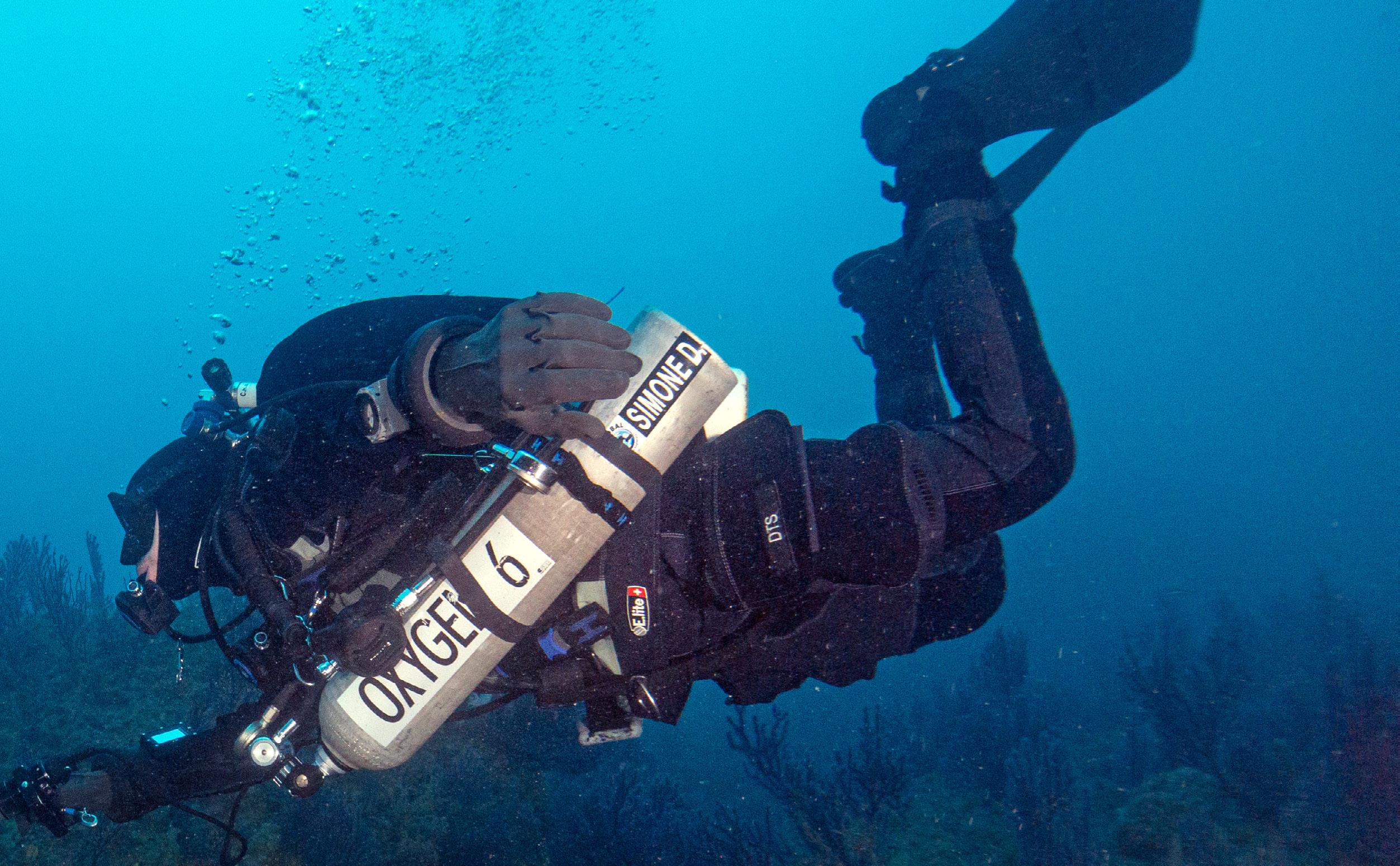
See the photogrammetric reconstruction here...
Nils Lucas Jacobsen is a marine biologist and passionate technical scientific diver. After completing a bachelor’s degree in biology, he went on to study marine biology, with specializations in conservation biology, impact assessment, and mitigation. In the framework of an international master’s program, he visited universities in Portugal, Italy, and France, and worked in research centers
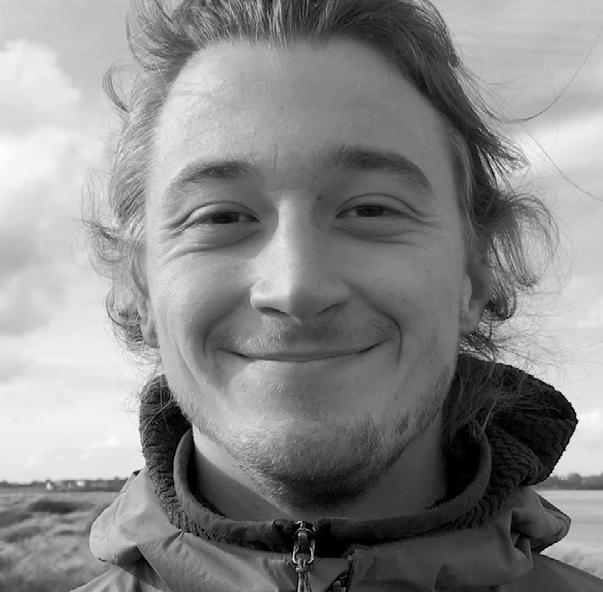
across Europe. The exploration and protection of undiscovered, pristine marine habitats is his main interest. Currently, he is exploring marine animal forests in the mesophotic zone.
www.nils-jacobsen.com

 Nils Lucas Jacobsen
Nils Lucas Jacobsen
21 February 2023 · Quest
THE EXPLORATION CONTINUES
Throughout the past year, the BEL cave exploration team continued its efforts to further traverse the many hidden corners of the vast Mayan Riviera cave systems in Mexico. The last season—from summer 2021 to summer 2022—resulted in the discovery of 12.7 km/7.9 mi of new underwater cave passages. The team was busy in multiple cave systems, and the number of new caves they encountered dive after dive exemplifies the extent and complexity of these Mexican caves. The continued potential of finding something new drives the small team to improve their skills, procedures, and equipment according to the different challenges they encounter in each section of the caves.
 TEXT BJARNE KNUDSEN, EMŐKE WAGNER & LÁSZLÓ CSEH
TEXT BJARNE KNUDSEN, EMŐKE WAGNER & LÁSZLÓ CSEH
22 Quest· February 2023 22 · February 2023
PHOTOS TOM ST GEORGE
EXPLORATION CONTINUES

Laszlo Cseh resurveying an old guideline in the Ox Bel Ha cave system.
23 February 2023 · Quest
PHOTO TOM ST GEORGE
YAX CHEN
THIS SMALLER PROJECT, LIKE 2020’S EXPLORATION effort, started from a well-known cenote called Yax Chen in the southernmost corner of the Ox Bel Ha cave system. The new area introduced some unique challenges to our diving, and the excessive rainfall during this period further complicated the picture for us regarding visibility. Although the team had to wait patiently for conditions to improve, the cave showed exciting possibilities, and the wait to push our discovery to the east-northeast was worth it.
As always, additional data was required, but this time we decided to examine the downstream side of the main opening more extensively. On a regular survey dive, the team discovered the beginning of a new, potentially unexplored area.
Quite early into the survey dives, we managed to reach one of Gary Walten’s end-of-lines from 1997, at a penetration distance of 1.6 km/0.9 mi. The line ended in front of a massive collapse of fallen rocks with just enough space between them for a diver in sidemount configuration.
As always, we wanted to swim in a little bit and check if the tunnel really ended. The strength of the flow was considerable, still flowing downstream into the rubble. As we climbed up the hill between the cracks, a bit of daylight was visible on the top of the pile. We tied in and brought our reel all the way to the crack.
Indeed, it was a cenote, but the way out was very small, even in sidemount, and on top of this, a log blocked our way. We were unsure if Gary or other divers ever saw this daylight source. In our excitement about finding a new cenote, we managed to pull the log to the side and tie it in place with a piece of cave line. We had to get our stages off, squeeze through, hand them to the first diver already on the other side, and put everything back on again.
Cenote Roots
Once we reached the other side, we immediately wanted to drop back down into the cave on the other side of the collapse—but it appeared to be even smaller, so we decided we would follow the flow of the water in the open. Unfor -
tunately, the cenote was in a mangrove forest and densely overgrown with roots that we had to cut our way through. After 57 m/187 ft, we reached the overhead again where another line from 1999 was waiting for us. We knew this was another connection between Yax Chen and historic Ox Bel Ha.
The strange thing was that, on this side of the cave—where the line was much closer to the cenote—apparently nobody had thought about traversing it. The cave here was very dark, full of organic sediment, shallow, tannic, and with roots that blocked most of the visibility. Maybe these conditions had discouraged previous explorers from moving on. Because of our challenging experience with the cenote, we named it Cenote Roots. On this side of the cave, we continued our survey, and it quickly became obvious that the east side of the main line here looked open. We decided to check leads here on the following dives.
Preparing for an exploration like this proved challenging at first. Although the distance wasn’t great, a restriction of this size can be a problem. If we wanted to find new cave here, this was the best and closest way through, so we had to get used to the challenge. It was time-consuming to unclip everything, hand all the stage bottles and DPVs through, gear up on the other side, and then continue, but with time, our efficiency improved.
Unfortunately, the first—and most promising— leads to the east very quickly began to die down as we discovered caves filled with dark, fluffy sediment and very irregular tunnels. Navigating more restrictions here did not help, and we tried to take other directions. Often, we were halted after a few months of rainfall that rendered the entire region undiveable due to the shallow depths and accumulation of tannins and hydrogen sulfide.
Slow progress
One of our leads, however, turned more southeast than east, featured a faster-moving flow, and offered improved visibility. After a longer wait, as the conditions slightly improved, we were back to finally check where this new line went.
24 Quest· February 2023
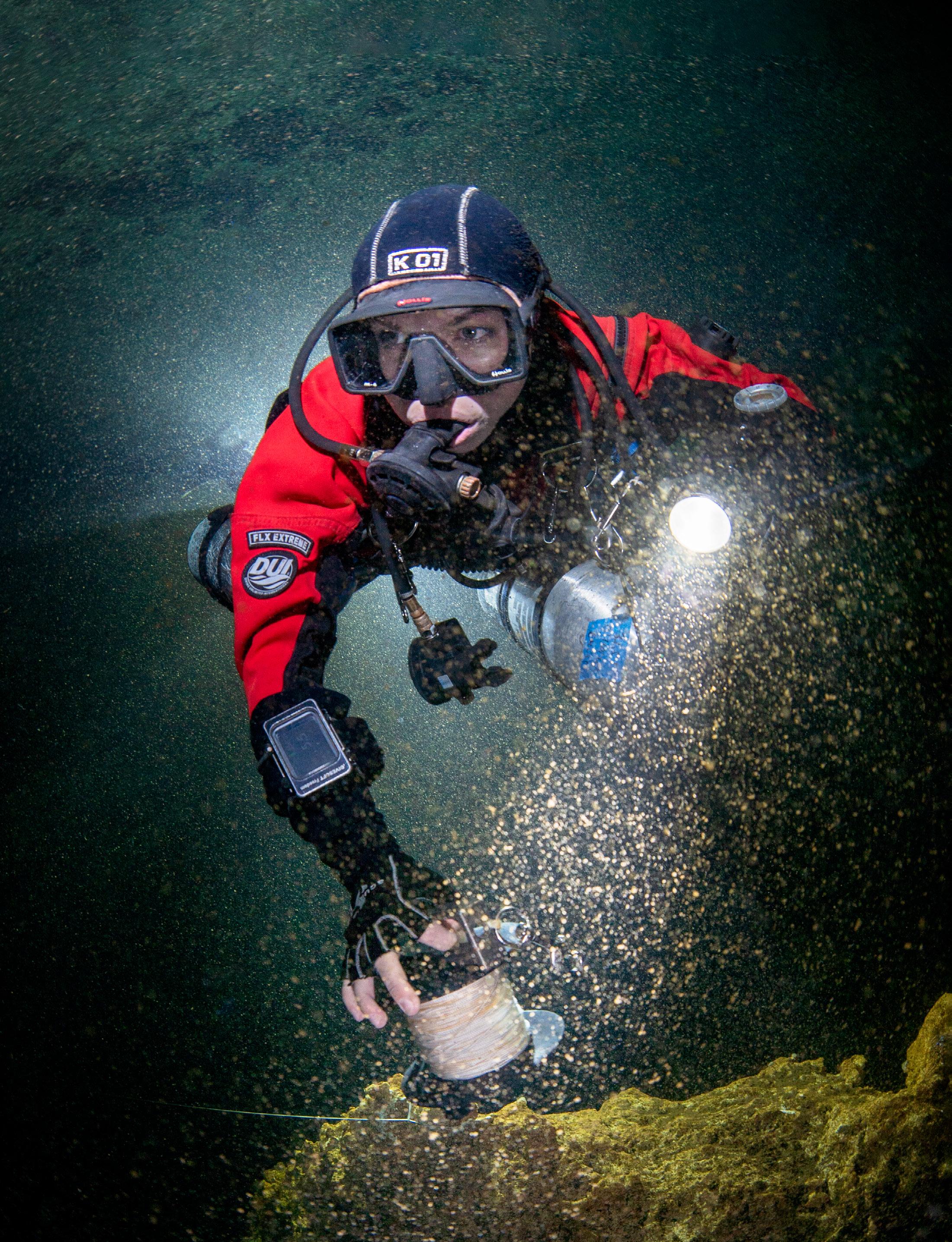
Cenote Roots and the cave behind it forced us to explore in worse conditions than usual.
25 February 2023 · Quest
PHOTO TOM ST GEORGE
 PHOTO TOM ST GEORGE
PHOTO TOM ST GEORGE
26 Quest· February 2023 26 · February 2023
Emöke Wagner in sidemount configuration exploring the Ox Bel Ha system, characterized by a lot of sediment and heavy percolation.
Unfortunately, after a few hundred meters, our line arrived at another sidemount restriction at about 2.3 km/1.4 mi of penetration. There was seemingly no other way around this one either. Past it, the cave changed in its configuration; it featured more solid, dissolved rock and plenty of collapses. We knew that by following this direction, we could get closer to the sea and maybe even connect to it. With further penetration, the number of sidemount-sized restrictions with an excessive amount of sediment increased.
The progress was slow and tedious—the cave seemed to have open rooms and hidden cracks around every corner, so identifying the best way to push on was difficult. It was also difficult to travel to our closest spot to the sea and, as we neared 3 km/1.9 mi distance from the entrance, we decided to look for a better way. Unfortunately, we were hit by another set of rainstorms, and the conditions worsened. Finally, we decided to dive regardless of the conditions. On the ‘99 lines, the visibility was close to zero. Sometimes you keep going further and further in hope
of the conditions improving, but it was not the case this time. However, since we were already there, we thought we would try to explore a better route toward the sea. In almost completely blind conditions, we tried to lay our line—from wall to wall until we hit something and by relying mostly on our compass, which was hard to see, too. After some trials, we managed to establish what seemed to be a decent-sized tunnel that made the travel close to the sea shorter and was also navigable by scooter. This new 300 m/1,000 ft tunnel became the new path of travel after our initial major restriction.
On subsequent dives, we managed to bring more gear through and were able to investigate for longer at our last leads. Despite being so close, we never managed to connect this part of the cave to the sea we were short by about 50 m/165 ft.

After this, when the conditions allowed, we moved to the north, tied some new, shorter lines into our exploration, and—by the end of the season—we had a new, fully connected section of 5.8 km/3.5 mi.
YAX CHEN // DIVE DATA
DIVE TEAM
Wagner, Bjarne Knudsen, and Laszlo Cseh
One new cenote and new connection between Yax Chen and historic Ox Bel Ha
NEW EXPLORATION DISTANCE 6.06 km/3.7 mi NEW CONNECTED AREA 5.8 km/3.5 mi AVERAGE DEPTH 6.5 m/21 ft MAX DEPTH 12.6 m/41 ft
GUE sidemount
SUEX DPVs
PENETRATION
km/1.86 mi
EQUIPMENT OC
with multiple stages and
LONGEST
3
from Yax Chen AVERAGE BOTTOM TIMES 7-8 hours with no required decompression
DISCOVERIES
Emőke
NEW
27 February 2023 · Quest
 PHOTO TOM ST GEORGE
PHOTO TOM ST GEORGE
28 Quest· February 2023 28 · February 2023
Resurveying existing lines is a key starting point to better understand the tunnels and identify possible new leads.
COKA HA EAST
AFTER THE EXPLORATION IN YAX CHEN , it was time for a change of scenery—the team was ready to focus their efforts in other places for a while.
Bil Phillips originally found and explored cenote Coka Ha in the early 2000s, and it is in the heart of the Ox Bel Ha cave system. Huge freshwater tunnels, dark cave decorations, and lots of percolation characterize most of this area.
In 2019, the team had access to the cenote and re-surveyed a massive and very defined passage going straight toward the east with a decent amount of flow. After numerous unsuccessful attempts to break out of this tunnel, either to the north or south, the team took a southeast turn toward the end of the line, following the water. As a result, they discovered two new cenotes (later named Muuch and Ookol) and a few open leads.
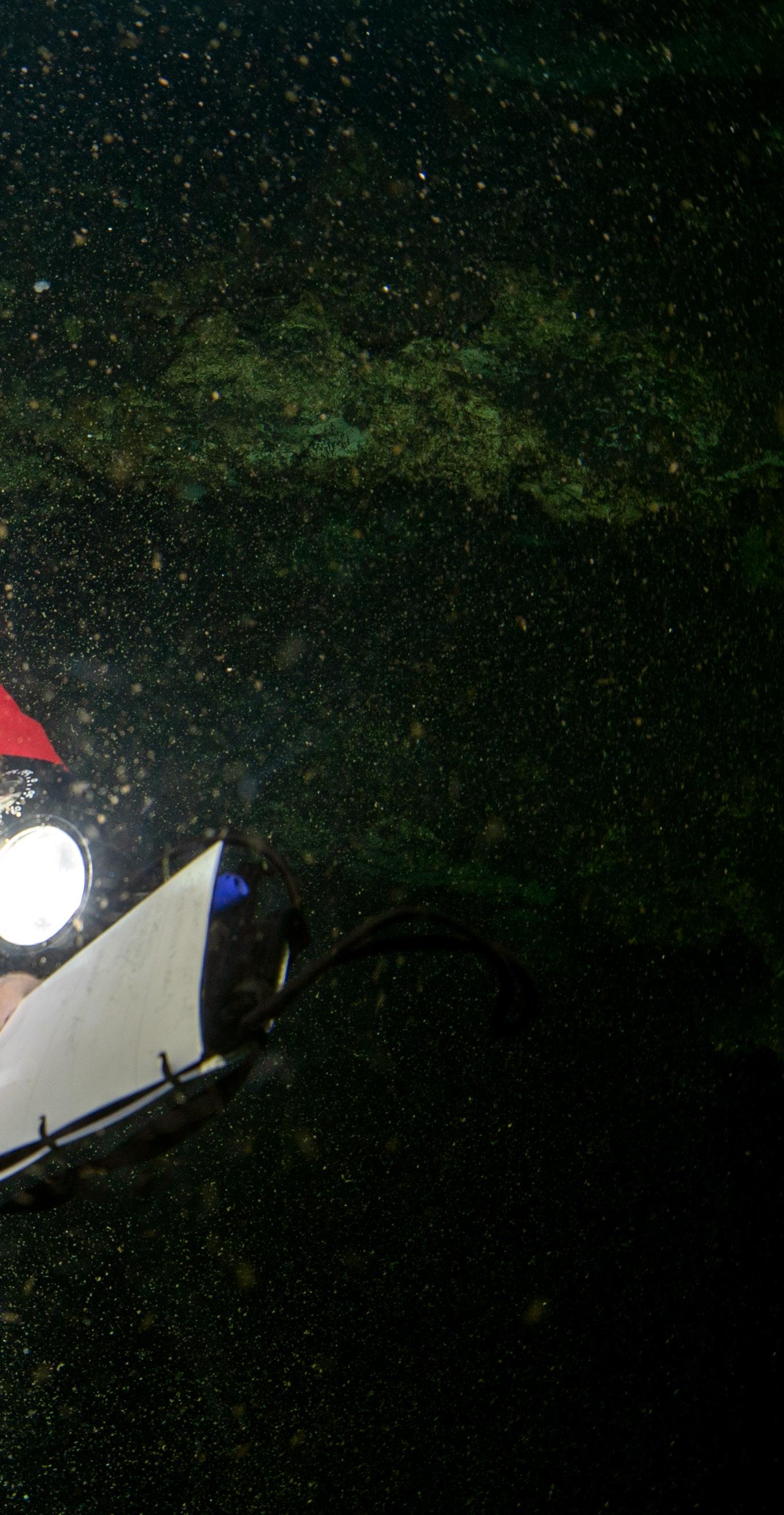
When the team suddenly lost access, the divers had to move to other exploration areas.
The team was still mulling over further possible paths from the new cenotes to the east, but the lack of direct access to the sinkhole complicated matters.
After finishing some other projects, the divers had time to return here in early 2022. But, they used cenote Chuup Ich as an entry point—about 2.6 km/1.6 mi north of Coka Ha. This added a considerable amount of travel, not counting the entirety of the east tunnel next to Coka Ha.
After checking survey data and making some calculations, the divers identified the current end of line at 4.1 km/2.5 mi from Chuup Ich. Prepared with special batteries for the DPVs and having enough experience and knowledge about the area, the team decided to initiate regular longer dives downstream from the entry point.
Bat cave
Luckily, 90% of the travel was comfortable— despite being fully overhead—with quite a lot
of navigational points and a few restrictions along the way. The team encountered one major restriction at a penetration distance of 3.6 km/2.2 mi but found a more navigable bypass tunnel nearby.
On the first dives, the team made good progress pushing the cave further to the east, hugging the east wall of the cenotes and dropping a bit deeper. After some irregular, small, and silty tunnels, the cave opened back up again into its regular size, where dark decorations loomed and the eastern water flow picked up again. Unfortunately, this only lasted for a couple hundred meters, at which point the cave hit a steep, silty slope with organic sediment. Swimming to the top, the divers found a small dry cave inhabited by bats and with a small source of light on the opposite wall. The divers named this little room “the bat cave” for future reference.
Initially, it seemed there was no way around the bat cave, but on a subsequent dive, divers discovered a drop down to the northeast next to the bat cave and continued in that direction. They hoped that this tunnel would loop around the bat cave, ascend a bit, and continue going east.
Once the cave took a northeast direction, the ceiling descended at the same time, and percolation followed the divers even more aggressively. The challenge in this area was to work as rapidly and efficiently as possible since there were only moments of visibility available for the first diver. If one lead wasn’t identified well, or took too long to check, we were looking at another 4.5 km/2.7 mi of travel for our next dive. Little by little, the team made good progress, but the cave never returned to its original depth and direction.
The cave was pushed further from this point in multiple directions, but all the leads became increasingly small or ended in a collapse. This area of the cave seemed to end close to 5 km/3.1 mi from our original point of entry. On the last dives, the team checked closer leads, but neither of them significantly deviated from the main east direction. Perhaps they are a side effect of the massive water flow straight to the east.
29 February 2023 · Quest
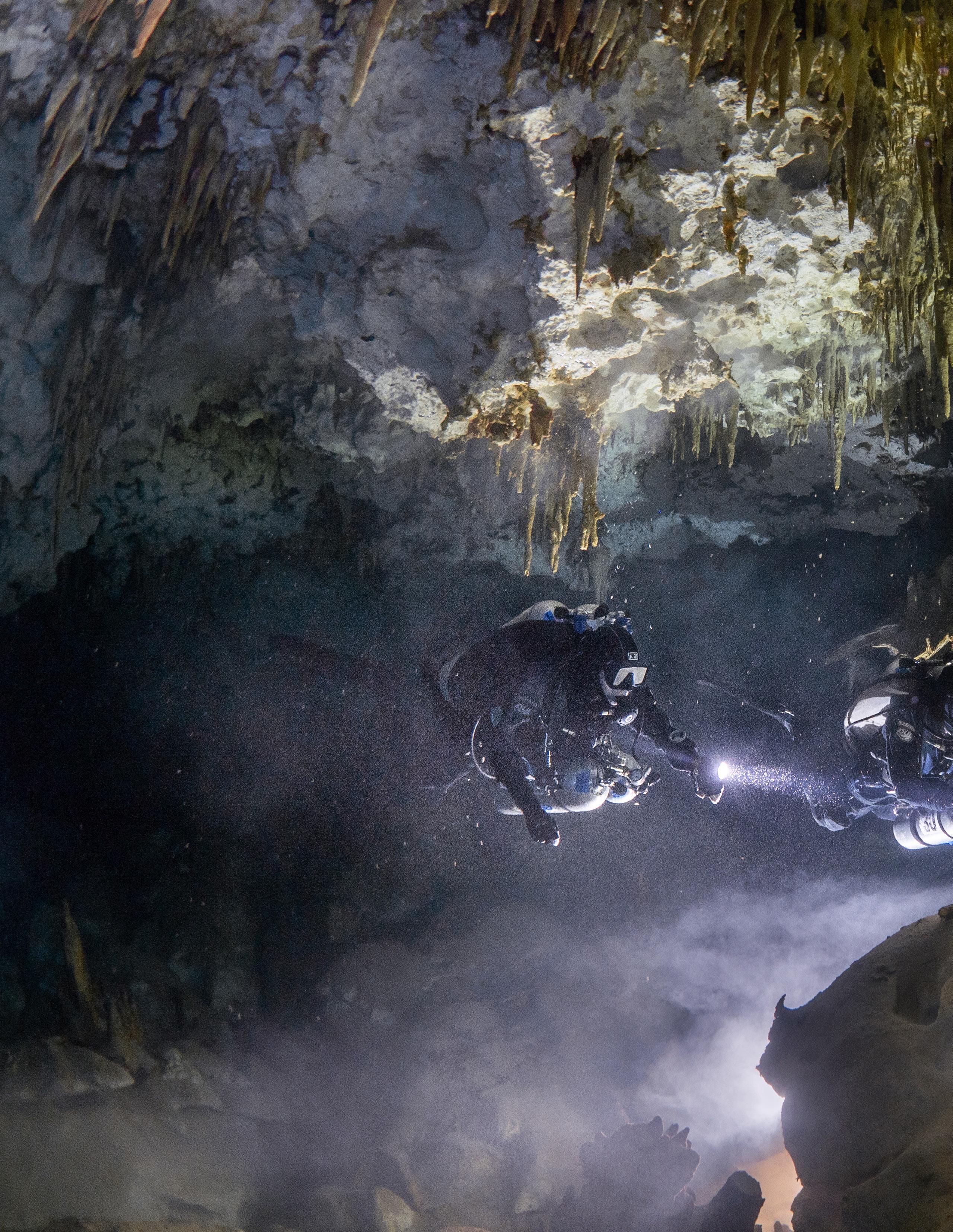
The team was still mulling over further possible paths from the new cenotes to the east, but the lack of direct access to the sinkhole complicated matters.
30 Quest· February 2023 30 · February 2023
PHOTO TOM ST GEORGE
The shallow depths of Mexican caves allow us to penetrate longer on opencircuit configuration.
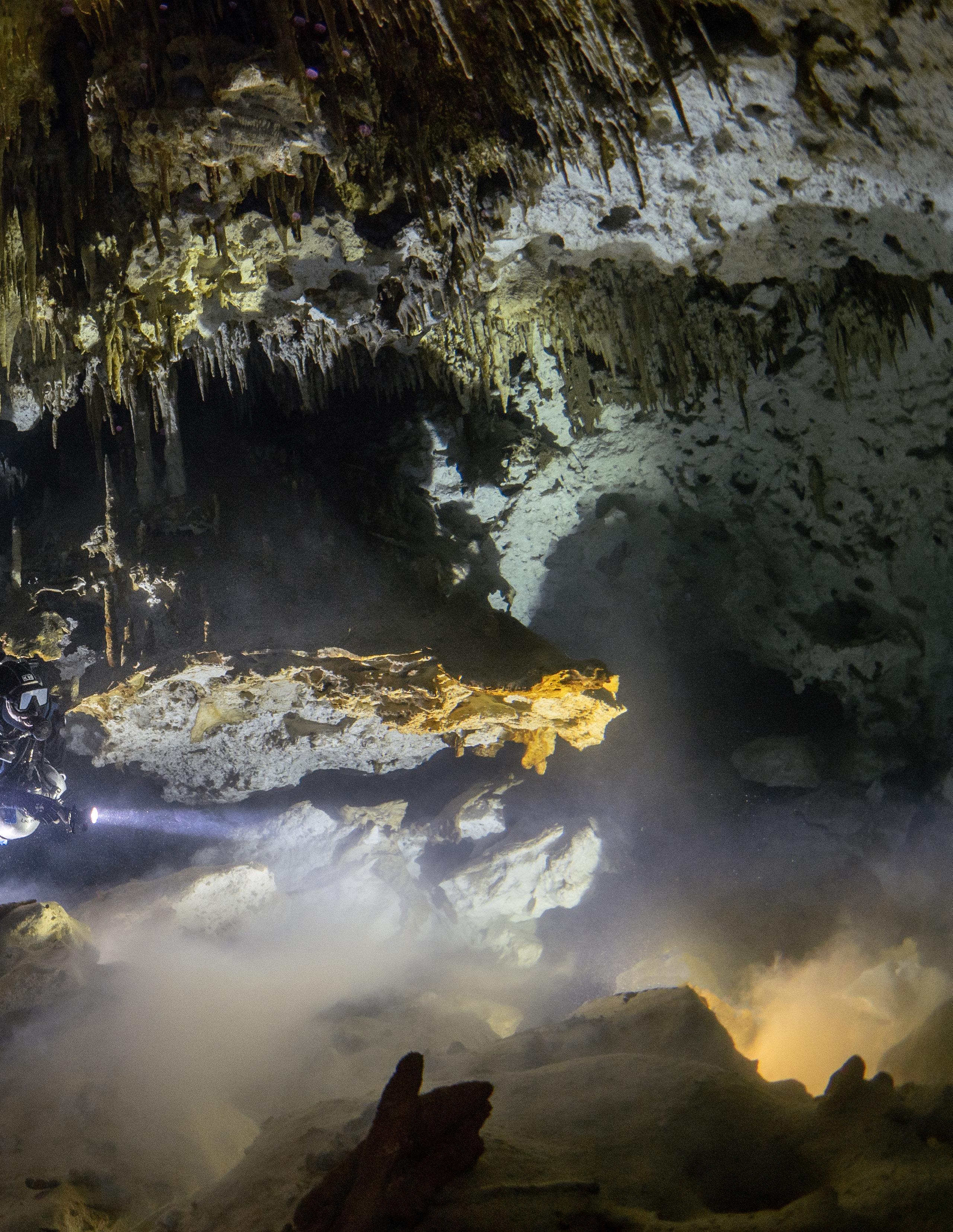
COKA HA EAST // DIVE DATA
NEW EXPLORATION DISTANCE 3.2 km/1.9 mi where 2.1 km/1.3 mi creates its own connected section
AVERAGE DEPTH 11 m/36 ft
MAX DEPTH 19.5 m/64 ft
EQUIPMENT OC GUE backmount and sidemount configurations with multiple stages and SUEX DPVs
LONGEST PENETRATION 5 km/3.1 mi
AVERAGE BOTTOM TIMES 6-7 hours with minimum decompression
DIVE TEAM Emőke Wagner, Bjarne Knudsen, and Laszlo Cseh
31 February 2023 · Quest
THE BEES
WE SCHEDULED ONE LAST, SMALLER PROJECT for this season after the Coka Ha exploration. This endeavor began at the end of 2021. The BEL team received additional help from Dr. Mario Valotta and Cameron Miller, who joined the exploration.
The Bees cenote is just a few kilometers north of Tulum. It belongs to the Sac Aktun cave system, and Paul DeLoach and Dr. John Zumrick first explored it. Robbie Schmittner and Kim Davidsson connected the northwest (“Naval”) and northeast parts of the cave (respectively) to Sac Aktun in 2004. The cave features many fractures and canyon-like tunnels and, being close to the sea, it has a wide network of passages with porous rock and heavy percolation in untouched areas.
This project happened by accident when survey divers discovered a decent-sized tunnel close to the entrance that was big enough to

comfortably carry gear further to the northeast, upstream section of the cave. As the divers regularly collected more data about the area, they discovered that the aforementioned tunnel created a huge shortcut compared to the existing lines leading to the same area. This encouraged the team to explore further and arrive relatively quickly and with less effort to areas that seemed unvisited in recent years or even since the original exploration.
The movement of the water seemed to come mainly from two directions—northwest and northeast—which created two main conduits in a V shape. The tip of the V is Abejas and from there, the water exits into the sea. Identifying this left the divers thinking of exploring the seemingly open area between the two main waterflow directions.
Backmount progression
As the team made their way farther north-northeast, they surveyed existing lines and added new, smaller lines that created more shortcuts
PHOTO TOM ST GEORGE
32 Quest· February 2023
Laszlo Cseh in backmount configuration looking for leads in the Abejas cave.
toward their desired area. One of the old northeast lines ended, but divers had observed a small but solid hill in a previous survey session. Once on top of it, a tunnel revealed itself and kept going for about 150 m/500 ft until hitting another old line. The newly installed line turned out to be the second connection between Abejas and the northeastern area of Sac Aktun after Kim’s connection in 2004. Luckily, the size of the new tunnel allowed for further backmount-sized, upstream progression.
In early 2022, this work continued with the help of DPVs. Traveling with more gear and dealing with complex navigation—even while using the shortcut lines—was not the most comfortable in some areas, but the slowly growing distance required the use of diver propulsion vehicles.
Very early on, the team arrived in an area that wasn’t well visited, and older exploration lines even started to decrease in some of the areas. This gave the divers the opportunity to start looking for leads into an open area.
Many of the initial leads to the west were promising at first, but they soon hit the saltwater level, and the tunnels decreased in size and eventually stopped.
Many of the initial leads to the west were promising at first, but they soon hit the saltwater level, and the tunnels decreased in size and eventually stopped. Uncommonly for the area— especially below the halocline—these saltwater tunnels were colored dark brown and black with a considerable amount of fine-grained sediment on the floor.
After their initial bad luck, the team moved further north and tried to break into the open western region at every possible opportunity. The biggest success occurred about 2 km/1.4 mi upstream from their initial starting location. A low-ceiling, freshwater room had a small opening on its far side. The cave opened into a defined—but very irregular—single tunnel that headed towards the northwest. This tunnel led to a large, highly decorated room with a collapse on its east side. Turning slightly south from here and navigating some restrictions, the team discovered another decorated room. It took some time to figure out the correct way from this location, but the cave took a hard west and contin-
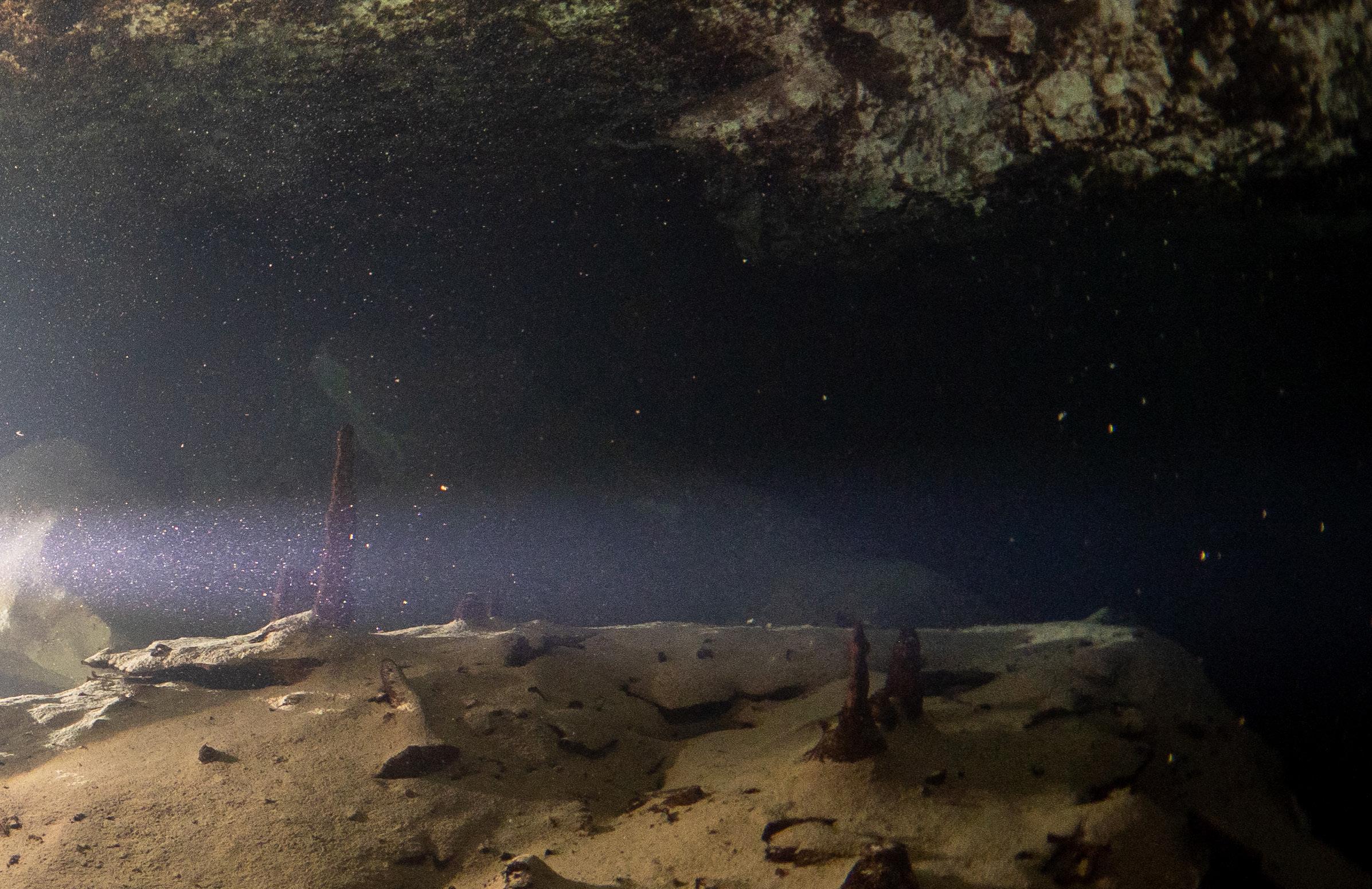
PHOTO TOM ST. GEORGE
33 February 2023 · Quest
ued for a few hundred meters. Although the new area had plenty of cave formations, it wasn’t nearly as solid or white in color as classic areas of Sac Aktun tend to be. The highly silty areas and percolation were manageable but ever-present, and the team did not encounter any other cenotes along their way.
The boneyard
For a short while, the cave almost seemed to stop. The team had to navigate around a collapsed area where, luckily, the cave continued on the other side. The cave started to change, and more collapses followed.
One of the collapsed rooms contained numerous prehistoric animal bone remains, including one side of a jaw. So far it is unknown to which type of animals the bones belonged to, but it was definitely an interesting find!
After the last collapse, the cave was not in the freshwater anymore and descended back below the saltwater level. Here, the cave again became darker and continued for a while, but no-flow conditions and increasingly smaller tunnels halted further explorations. This new area had a promising start, but after 2.4 km/1.5 mi of new line, there were no signs left of tunnels going further west.
Final thoughts
Even well-explored caves can conceal (sometimes very well-hidden) secret corners. It is impossible to tell with 100% certainty that a given section of a cave is fully explored due to the complex nature of the underground passages. Efforts like this show how much of these systems we still don’t know and have not discovered yet. One of the strongest tools and approaches towards a successful exploration is survey. Even if the cave contains lines, revisiting sections and collecting accurate data can lead curious divers to uncharted places.
ACKNOWLEDGEMENTS
We are very grateful for the support we have received to complete all these endeavors.
Thank you to:
• Dr. Mario Valotta, who acted not just as a valuable team member in the water, but also gave his support in the form of additional equipment needed.
• Cameron Miller, for his commitment to go through some challenging dives with us.
• Cuzel Filling Station, who supported the projects with GUE standard cylinders and gas fills, sometimes even in the evenings at the end of our long exploration days.
THE BEES // DIVE DATA
DIVE
between Abejas and
Emőke Wagner, Dr. Mario Valotta, Cameron Miller, and Laszlo Cseh
NEW EXPLORATION DISTANCE 3.5 km/2.1 mi with a new connected distance being 2.4 km/1.5 mi AVERAGE DEPTH 9 m/30 ft MAX DEPTH 13.3 m/43 ft EQUIPMENT OC GUE backmount configuration with multiple stages and SUEX DPVs LONGEST PENETRATION 3 km/1.8 mi AVERAGE BOTTOM TIMES 5-7 hours with minimum decompression NEW DISCOVERIES
bone site and one new connection
A
Northeast Sac Aktun
TEAM
34 Quest· February 2023
Bjarne began diving in 1993, taking his first tech classes in 1997 and his first GUE cave and tech classes in 1999, so he has been part of the GUE community since the early days. In the early 2000s, he spent several years in Florida, where he was a part of the WKPP. During this time, he also pushed Sheck Exley’s end of line in the Cathedral cave system. Bjarne is currently on a world cruise with his wife on their sailboat. For the last few years, they’ve been stuck in Mexico.
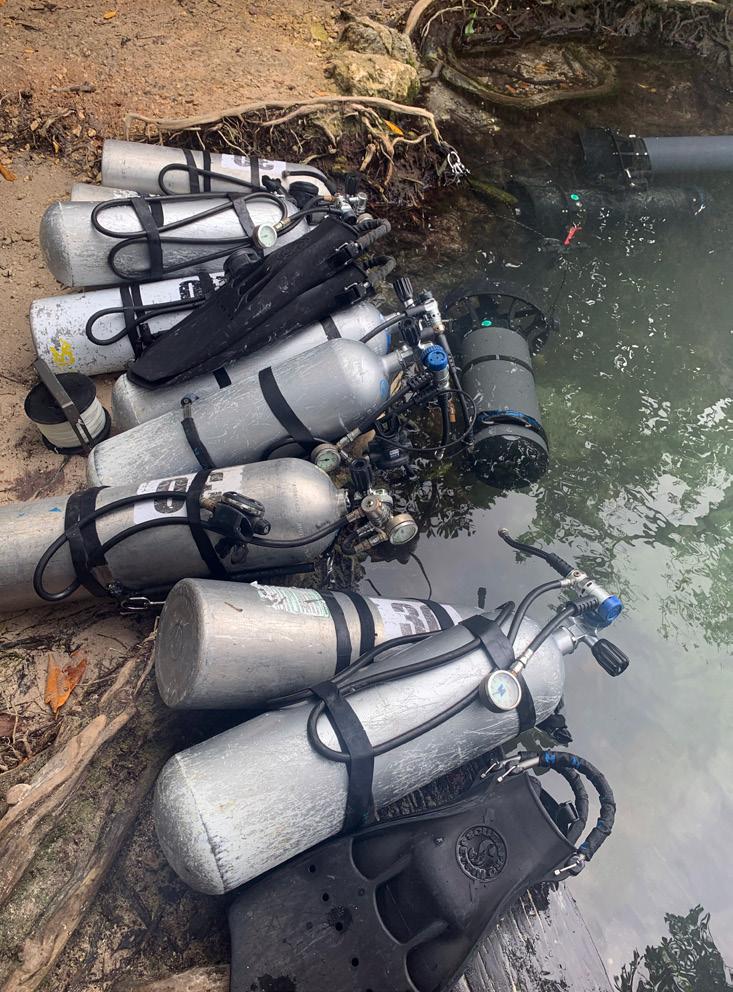


Emőke Wagner is originally from Hungary and began diving at a young age. She has been an active instructor since 2014. After a couple of years spent traveling around the globe, she moved to Mexico with her husband in 2017. While living in Mexico, cave diving became her real passion, and she began exploring more of the local cave systems. Since 2016, Emőke has been working as a full-time GUE instructor and is currently teaching the cave, foundational, and recreational curricula.
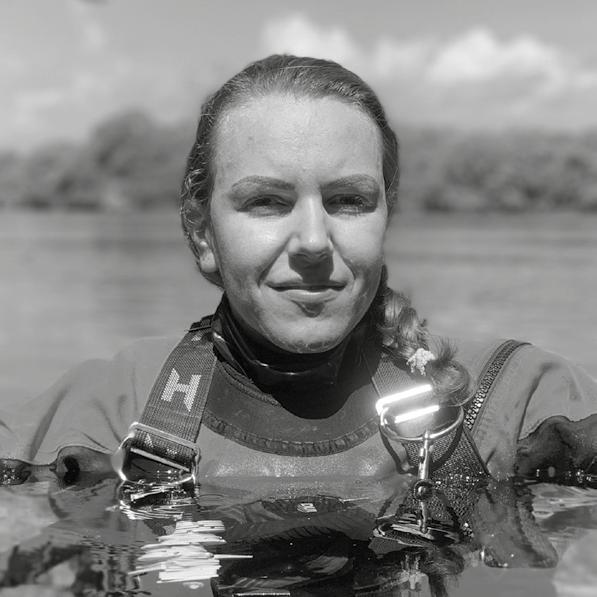
László Cseh is from Hungary and has always been fascinated with the underwater world. He became a recreational diving instructor in 2012 and began teaching and traveling with his wife, Emőke. After becoming a GUE instructor in 2016, he moved to Mexico to look for new diving challenges. Local cave exploration possibilities helped him achieve his GUE cave instructor certification.

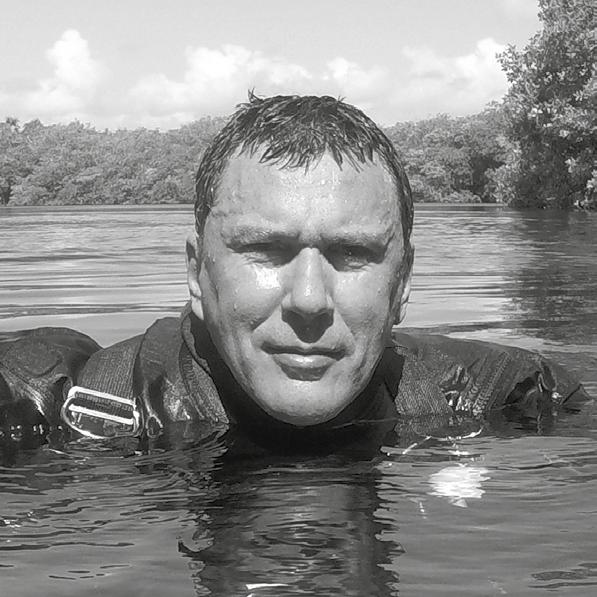 László Cseh
Bjarne Knudsen
László Cseh
Bjarne Knudsen
35 February 2023 · Quest
Emőke Wagner
BECKY KAGAN SCHOTT
Driven by passion
ecky believes the biggest secret to successful underwater photography is passion. When shooting something she is interested in and feels inspired by, she believes that it shines through in the imagery. She began diving 28 years ago with big dreams of traveling around the world, but she had no idea how to achieve that. Becoming a professional underwater photographer and cinematographer was not an easy road, but it was a rewarding one. Becky literally learned to shoot in the dark when she picked up a camera and began underwater photography in Florida caves. She enjoyed the challenges involved in trying to capture more extreme environments, and she found that there were unique opportunities for telling stories about historic shipwrecks or cave
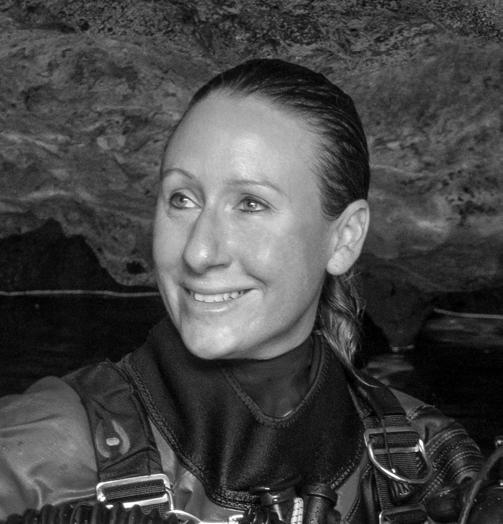
Bexploration. Her biggest passion is shooting haunting images of shipwrecks in the Great Lakes. She likes to combine art with powerful stories of tragedy, mystery, survival, and exploration to ignite viewers’ imaginations. Each wreck has a story to tell, and combining powerful imagery with a compelling story helps bring that shipwreck to life.
– I continue to push the limits of technology and try new creative lighting techniques to capture the beauty of the underwater world, and I never stop growing. In the past few years, I’ve been producing high quality photogrammetry models which also showcase shipwrecks in a way divers and non-divers can explore. When I dreamed of a career as an underwater photographer, I never imagined I’d be shooting in the Arctic to Antarctica or helping to document expeditions on deep wrecks or ice diving, but these environments and stories have captured my heart, and I hope they capture yours, too, says Becky.
www.liquidproductions.com


TITLE Ghost Ships
LOCATION Isle Royale, Lake Superior CAMERA Nikon D850
HOUSING Aquatica Digital LENS Nikkor 16mm EXPOSURE 1/60, f6.3
FLASH 3 x Light & Motion Sola Pro
15,000 lights and a Sola 9600
COMMENTS The SS Kamloops sits preserved with intact wheel, telegraph, and binnacle on the stern in Lake Superior’s deep water.
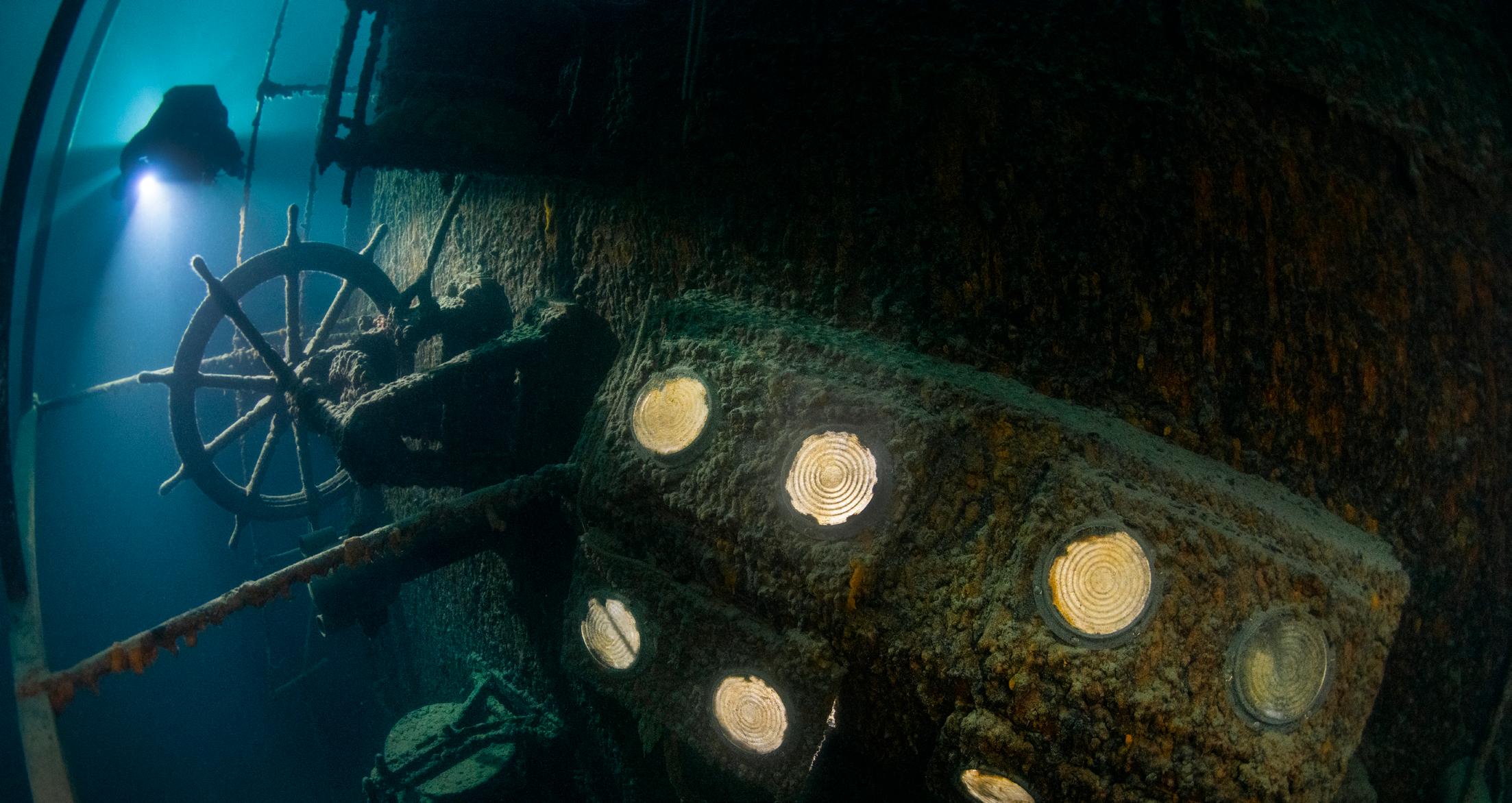
36 Quest· February 2023
LOCATION Bimini, Bahamas

CAMERA Nikon D700
HOUSING Aquatica Digital
TITLE Underground palace LOCATION Abaco, Bahamas
CAMERA Nikon D850
HOUSING Aquatica Digital
LENS Nikkor 16mm
EXPOSURE 1/60, f7.1
FLASH 2 x Ikelite 161s and 3 x video lights
COMMENTS Diving Crystal Palace in the Bahamas feels like swimming through a fairytale world.

LENS Nikkor 14-24mm
EXPOSURE 1/400, f11
FLASH Natural light
COMMENTS Waiting to hit the shutter when you feel and see that perfect moment.
37 February 2023 · Quest
TITLE Dancing with dolphins
TITLE A Leopard seal’s sinister smile

LOCATION Antarctica
CAMERA Nikon D850
HOUSING Aquatica Digital
LENS Sigma 15mm
EXPOSURE 1/500, f8
FLASH Natural light
COMMENTS Patience pays off while freezing in -2°C/29°F water, waiting for Antarctica’s apex predator to pass by.
TITLE Sharky Sunsets
LOCATION Grand Bahama
CAMERA Nikon D800
HOUSING Aquatica Digital
LENS Nikkor 14-24mm
EXPOSURE 1/200, f13
FLASH 2 x Inon Z-240s
COMMENTS Waiting for an underwater sunset and for sharks to swim by.
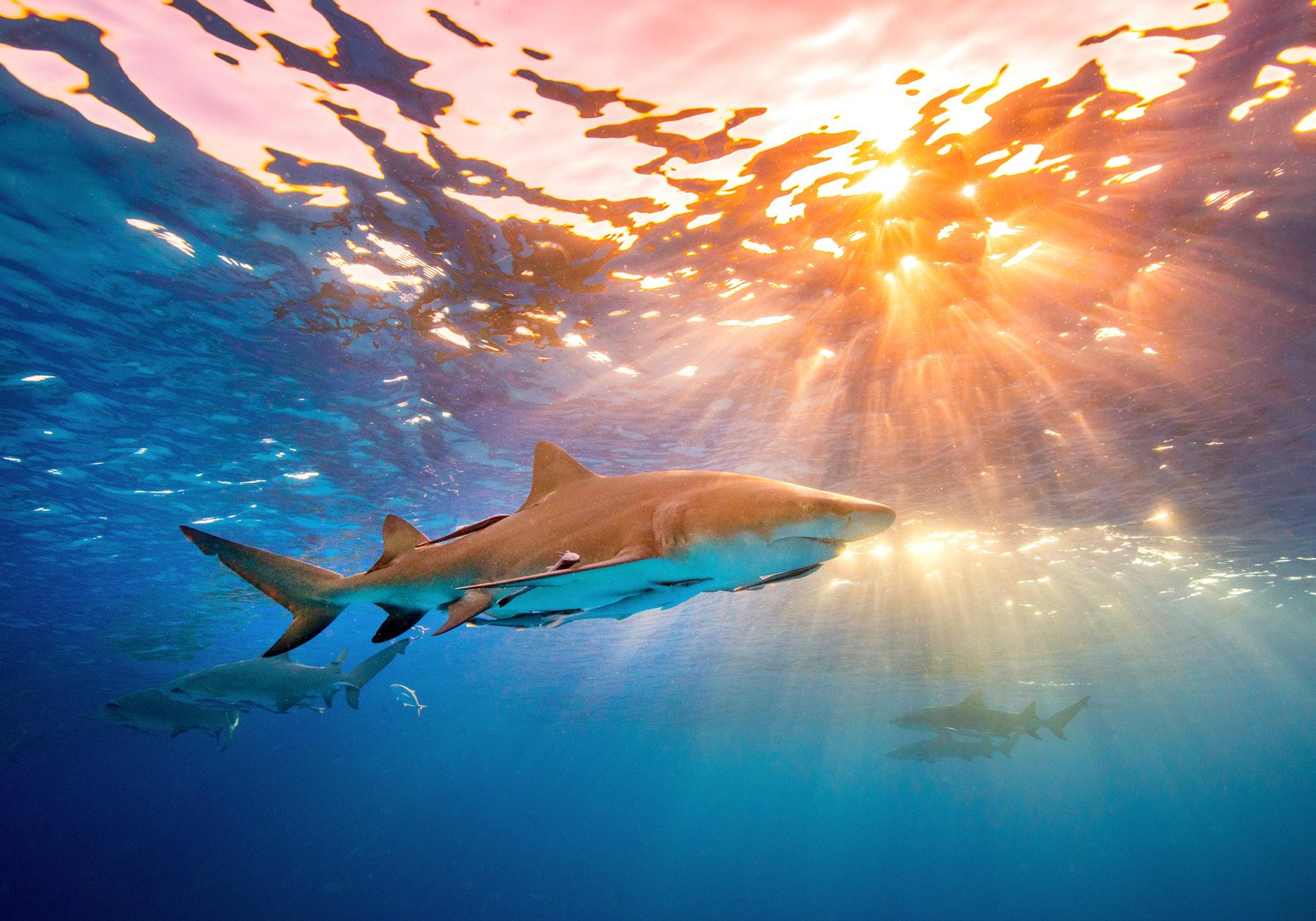
38 Quest· February 2023
TITLE Rio de Janeiro Maru engine room
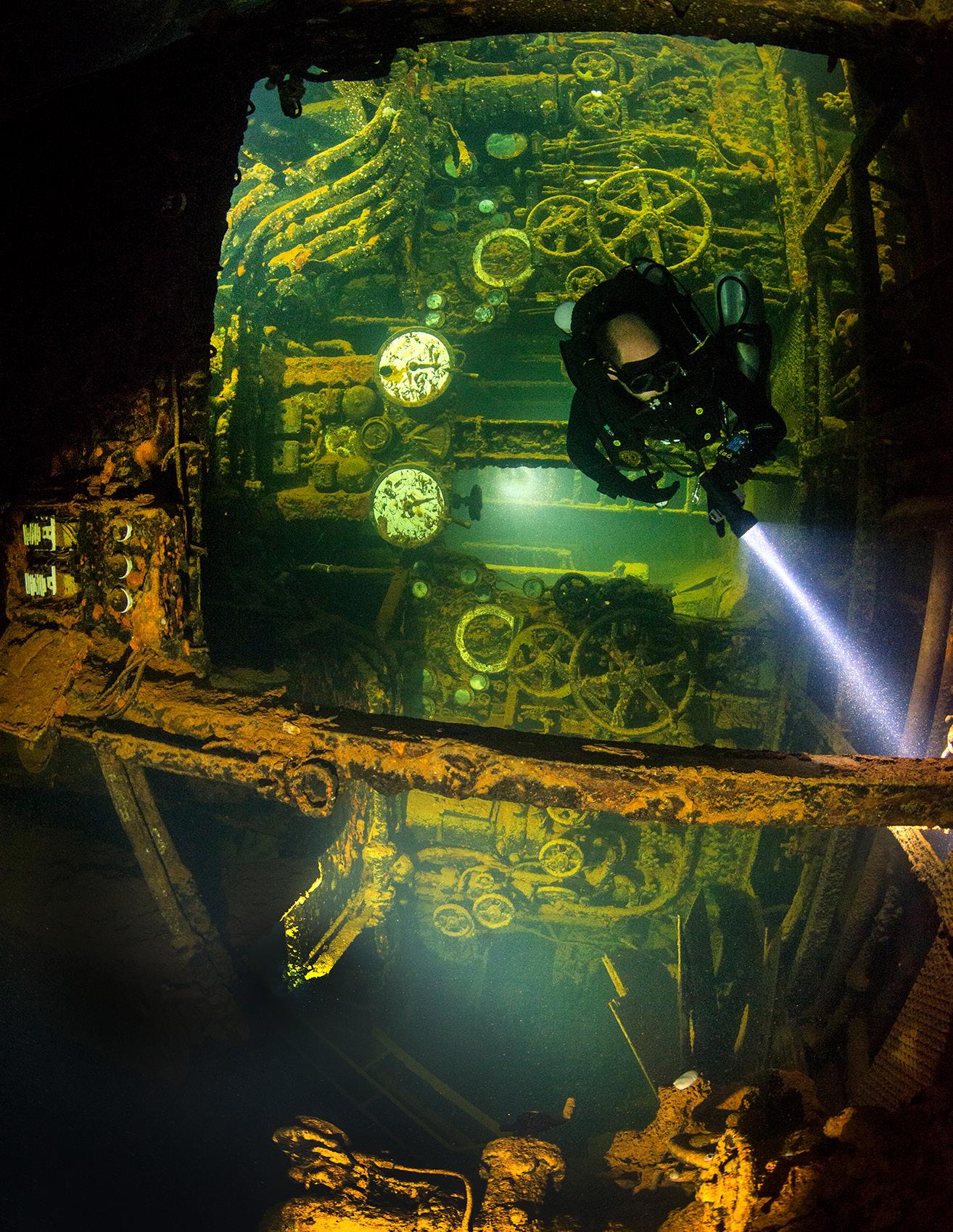
LOCATION Truk Lagoon
CAMERA Nikon D850
HOUSING Aquatica Digital
LENS SIGMA 15mm
EXPOSURE 1/80, f7.1
FLASH 6 x Light & Motion Sola 9600s and 2 on-camera Sola 8000s
COMMENTS This shot was the first of its kind and took me 50 minutes to set up and tweak before taking only a few shots on the dive.
39 February 2023 · Quest
TITLE Ice caves LOCATION Alaska

CAMERA Nikon D850
HOUSING Aquatica Digital LENS Nikkor 14-24mm
EXPOSURE 1/125, f6.3
FLASH 2 x onboard Light & Motion Sola Pro 15,000s
COMMENTS Exploring a glacial moulin for the first time.
40 Quest· February 2023
LOCATION Lake Huron, USA
CAMERA Nikon D800
HOUSING Aquatica Digital LENS Sigma 15mm
EXPOSURE 1/40, f7.1
FLASH Natural light
COMMENTS I like having a diver in my images to show scale and allow the viewer to connect with the wreck.
TITLE SS Cedarville LOCATION Lake Huron, USA

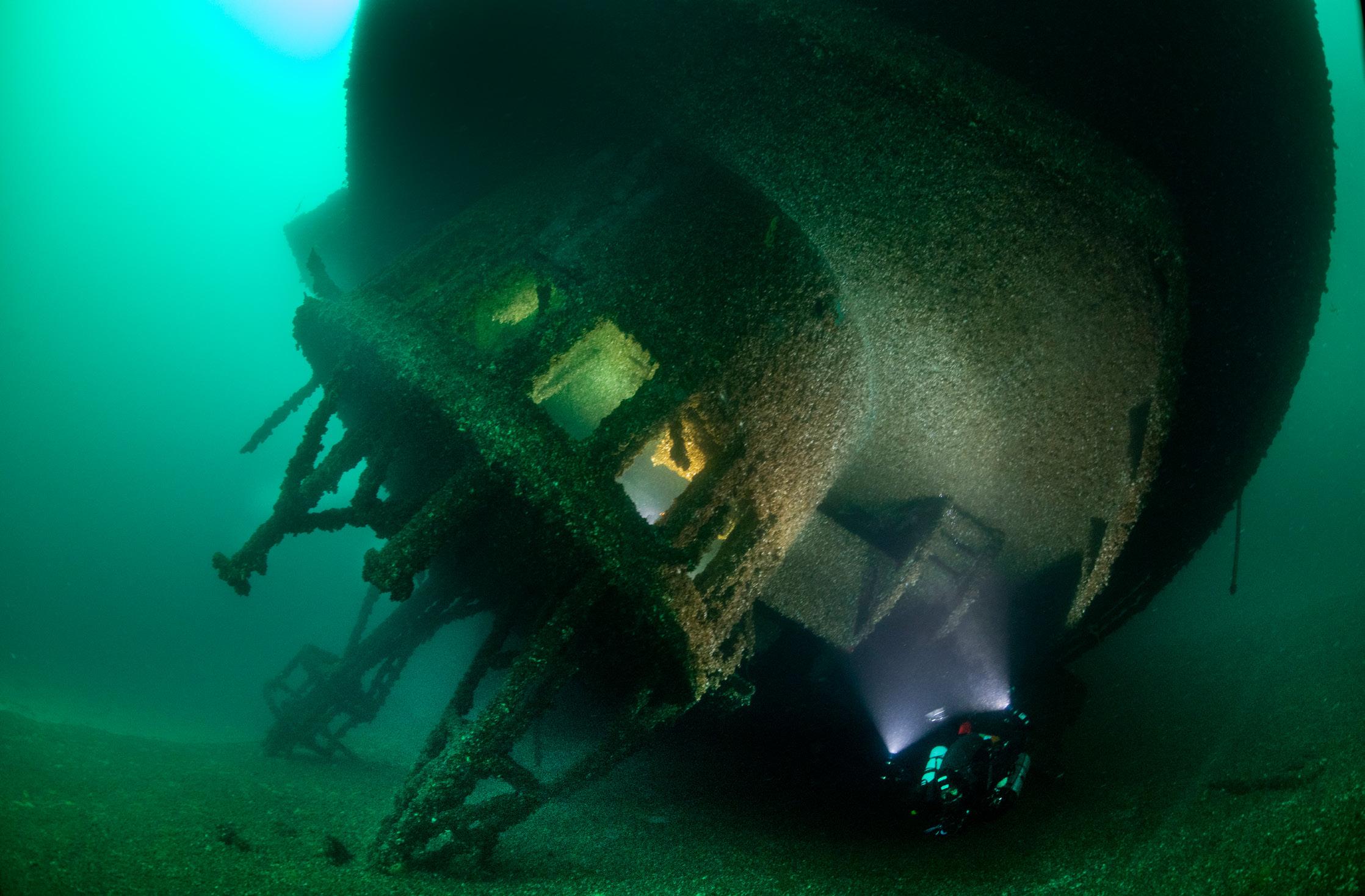
CAMERA Nikon D850
HOUSING Aquatica Digital LENS Sigma 15mm
EXPOSURE 1/30, f7.1
FLASH 5 x Light & Motion Sola
9600s and 2 x Big Blue 15k
COMMENTS This shot took three years to achieve due to the shallow depth, turtled wreck, and harsh shadows and lighting
41 February 2023 · Quest
TITLE Facing history
DecoPlanner
– past, present & future
If you have taken a GUE tech or cave class, you have most likely heard of a software called DecoPlanner. It has long been the tool that has formed the basis of most decompression schedules used by GUE students. Let’s take a look at where it started, what the current state is, and where it might be heading.
 TEXT ANDREAS HAGBERG
PHOTOS ANDREAS HAGBERG & JESPER KJØLLER
TEXT ANDREAS HAGBERG
PHOTOS ANDREAS HAGBERG & JESPER KJØLLER
42 Quest· February 2023
DecoPlanner

43 February 2023 · Quest
In1994, UK native Simon Tranmer, the original author of DecoPlanner, began his diving career with a PADI Open Water course in the Maldives. Back in the UK he continued his training with more PADI courses and ended up with a Master Scuba Diver rating by July 1995. He then joined a branch of the British Sub-Aqua Club (BSAC), where he met Graeme and Sue Davison, Andy Kerslake, and Keith Bellamy. They all went on to train with Jarrod Jablonski.

– In 1997, I did a trip with the group from the club to Scapa Flow where I did a TDI Advanced Nitrox Diver course taught by Graeme and a TDI Staged Deco course with Keith Bellamy. Back in our accommodations in the evenings, we all discussed decompression theory—obviously, as it was the main focus of the courses. They were all bemoaning the fact that managing decompression, especially on multi-level dives, was very
difficult and that it would be great if someone could come up with an easier way. As a professional computer programmer with a lot of experience, and probably some misplaced optimism, I suggested that I could write a program to do these kinds of calculations, remembers Simon. And so, it began.
– I started to assemble the program, and the guys from the club put me in touch with Erik C. Baker (the American engineer who introduced the gradient factor concept). He supplied me with a ton of information about the research he had been doing. Once I had the program in a state where we could generate some profiles and had incorporated some of the information from Erik about gradient factors, we started using it and comparing it with profiles generated from other sources. It seemed to produce what we thought were good results. I shared the program with Graeme, Sue, Andy, and Keith and they started testing it too. My own diving got more technical, and my buddy Paul Brown and I started using the program for all our dives.
Andreas Hagberg on a quick 88 m/290 ft morning dive in Diepolder 3, Florida, and then back to coding DecoPlanner in the afternoon.
44 Quest· February 2023
PHOTOS ANDREAS HAGBERG
– Paul, Andreas, and I went on to train with GUE—passing Cave 1 in 2002 with Tamara Kendel—and Paul and I did Cave 2 in 2004 with David Rhea, Simon ends.

Simon retired from diving in 2013 at the age of 60 after the development of a knee problem that made frog kicks painful.
Enter Andreas Hagberg
GUE founders and instructors were using the DecoPlanner software from the organization’s inception in 1998, and the source code was passed on to GUE around 2000. At this point in time, version 2.0 was in use. The development slowly progressed towards a version 3.0 with the help of other British coders who wished to remain anonymous.
In the early 2000s, I had earned a university degree in software engineering in Sweden, and in my spare time I developed a small multi-platform program for helping with nitrox and trimix gas filling and related calculations (Gas Management Program), as well as a very simple dive
help
finishing up the development of DecoPlanner towards a 3.x release, which I happily did.
log program. As these programs were aimed towards GUE divers, Jarrod Jablonski became interested in distributing them through GUE.
In 2005, Jarrod asked if I could help with finishing up the development of DecoPlanner towards a 3.x release, which I happily did. The following year brought me to Florida and a full-time position at GUE as webmaster and programmer.
Complete rewrite
A few subsequent versions were developed and released on the original code base, which was Visual Basic. As Microsoft reduced their support for this development platform, it became apparent that migrating the code to a newer standard would be a considerable undertaking. We had some options. Did we want to stay on a development platform where some of the old code could potentially be re-used, or migrate to a different coding language that could work on multiple different end-user platforms?
As most GUE instructors were using Mac computers, we decided on the latter. About a
45 February 2023 · Quest
“In 2005, Jarrod asked if I could
with
decade earlier, I had already translated some of Erik Baker’s Fortran code to Java, which I used in a tool that analyzed the gas loading from real dive profiles downloaded from the old Sensus Pro dive loggers. Because of this, deciding to rewrite DecoPlanner from scratch in Java (JavaFX, specifically) felt a bit more sensible compared to starting from nothing.
Familiar layout
For many years, Mac users had been using different kinds of Windows emulators or parallel environments to run the Windows-native DecoPlanner on their Mac computers. Around 2021, the most popular Windows emulator tools became incompatible with the latest releases of macOS, and the need for a macOS-native version of DecoPlanner felt more pressing.

The new rewrite of DecoPlanner was released as version 4.0 in October of 2021. As the straightforward user interface has always been one of the distinguishing and much appreciated features of the software, the same tables-based data input sections were recreated in version 4,
although using a more modern look and feel. To some users, this felt outdated and “old,” while others were relieved to see the familiar layout.
DecoPlanner and ratio deco
An interesting chapter of decompression planning and GUE has been the concept of ratio deco. Although a bit late in the game, DecoPlanner 4 now includes a section aimed at those who use this method. The term ratio deco spread outside of GUE classes, but it seems the term was not well understood early on, and different interpretations unfortunately gave the term a life of its own. With its inclusion in DecoPlanner, my hope is that more people will find it easier to understand the concept.
Since GUE first started using the principle, it has been adopted by copying agencies and groups to mean something different than how GUE first used it. For a number of years, it could be a frustrating exercise trying to discuss most things regarding ratio deco, as different groups have created different meanings of the term. Some divers reported that ratio deco was too
46 Quest· February 2023
The early versions of the software only ran on Windows-based PCs. Mac users deployed various Windows emulators to be able to use DecoPlanner.
DecoPlanner 4 now allows for constant pO2 plans to be used for planning rebreather dives.
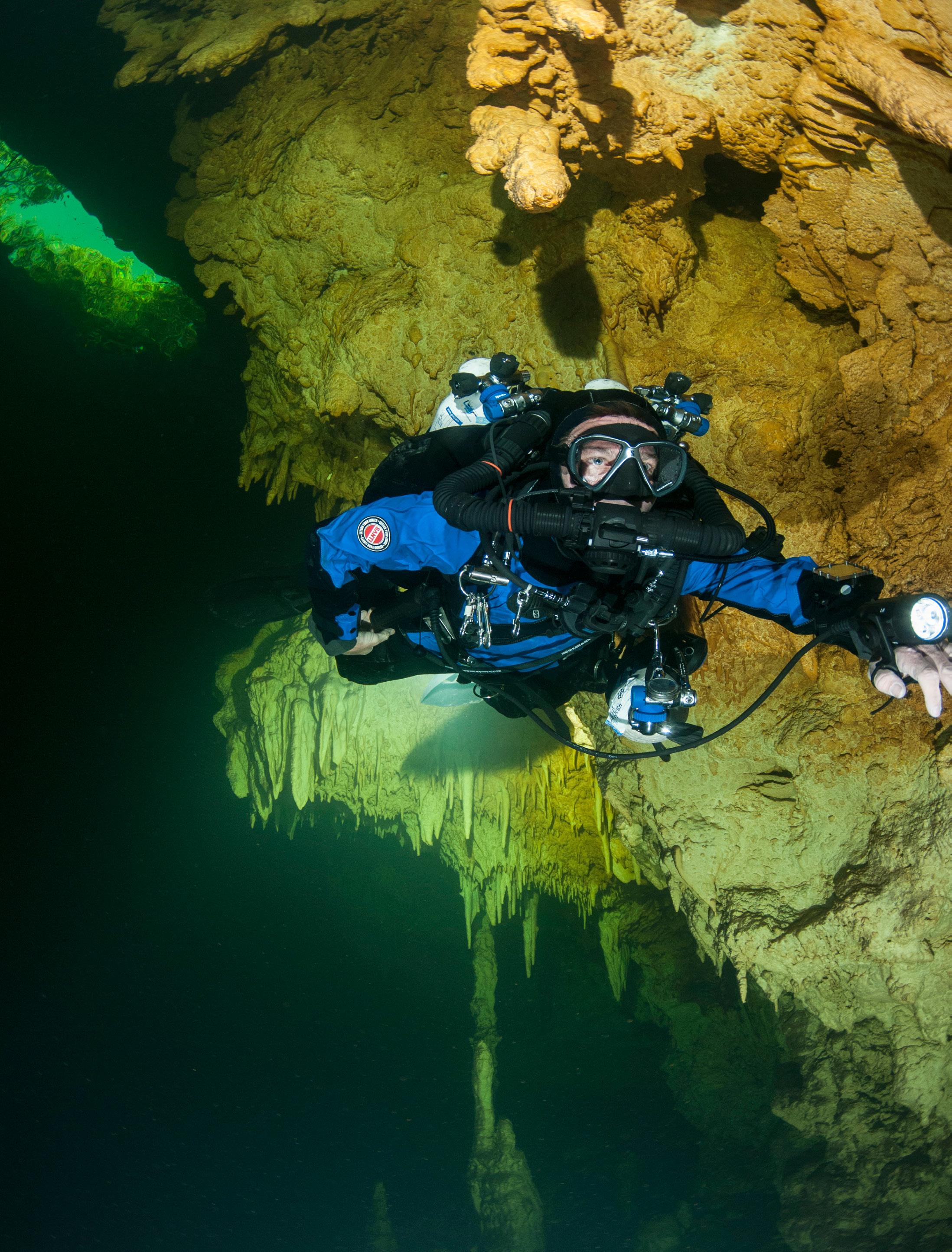
“
For a number of years, it could be a frustrating exercise trying to discuss most things regarding ratio deco, as different groups have created different meanings of the term.
47 February 2023 · Quest
PHOTOS ANDREAS HAGBERG
aggressive for them, which immediately made it clear that we were not talking about the same thing, as the concept of ratio deco does not define any sort of conservatism.
Looking at the concept alone, a ratio deco plan could be made from any decompression plan created from any decompression model and any conservatism setting there may be. However, many chose to focus on what was often taught as a good starting point in GUE’s tech classes, which was originally based on the first model available in DecoPlanner: Bühlmann ZH-L16b with gradient factors 30/85. To many, ratio deco represented this exact setting in DecoPlanner, followed by a rearrangement of stop times to create a linear ascent for each interval of stops for a certain decompression gas. While the standardization of this approach was useful to get larger groups of people to use roughly the same decompression profiles, it still often seemed like many people went through the GUE tech classes and still missed the full potential of the ratio deco concept.
It’s all in my head
Back when the VPM-B model was considered the latest and greatest, I personally liked to use ratio deco plans based on VPM-B. This approach was not always met with understanding. I vividly remember a dive in a deep Florida cave called Diepolder 2 when midway through our decompression, I realized that my decompression plan only existed in my head. (Bottom timers were still the GUE thing to use at the time). I didn’t even have the decompression plan in my wetnotes anymore. I was diving often and had the VPM ratios memorized well, so I was not concerned. But, as I was diving
with non GUE-trained divers (all wearing fancy trimix computers), I remember never feeling completely comfortable telling them that I was diving a “ratio plan based on VPM tables” without even being able to show them that exact plan. I was concerned that a lack of understanding could take an ugly turn and restrict my access to these dives. Therefore, my official statement was often that I was diving “VPM tables,” and luckily no one asked to see those tables at the dive site.
In DecoPlanner 4, I finally decided to add a small section that would allow people to see how the original term ratio deco can be used, even though the popularity and use of the term had somewhat faded. For those that want to write down a large set of tables in their wetnotes, they now have the option to take a quick look at the ratio section in DecoPlanner and write down the approximate ratios for any decompression plan they might want to follow—be it open-circuit, closed-circuit, ZH-L16, or VPM. With the popular use of dive computers, these written plans will likely only serve as emergency plans for most. In a future version of DecoPlanner, this section of the software will likely be optional (removable), for those that see it as an unwanted distraction.
DecoPlanner Mobile
Along with DecoPlanner 4, which runs natively on Windows and macOS (for desktop/laptop), you also get the new DecoPlanner Mobile for both Android and iOS (for phones and tablets). Divers have wanted a mobile version for a long time, but it regrettably never made it to the top of my priorities. Looking back at the last decade and a half, it seems my spare time was
 PHOTO JONO ALLEN
PHOTO JONO ALLEN
“
48 Quest· February 2023
In DecoPlanner 4, I finally decided to add a small section that would allow people to see how the original term ratio deco can be used, even though the popularity and use of the term had somewhat faded.
DecoPlanner 4 now runs natively on Windows and macOS, and is available as DecoPlanner


Mobile for both Android and iOS.
DecoPlanner
Mobile has a different user interface.
49 February 2023 · Quest
JARROD ON DECOPLANNER
GUE Founder Jarrod Jablonski explains his approach in working with Simon Tranmer, Graeme Davison, Sue Davison, Andy Kerslake, and Erik Baker in developing DecoPlanner.
MY PRIMARY GOALS IN WORKING WITH Erik, Simon, Graeme, Andy, Sue, et al. in the development of the program were twofold. First, I wanted to help create a very simple program that allowed divers to make changes at any point in the dive easily and quickly. I wanted to stay away from the graphical games that take a lot of time. We wanted a program that was for diving—an application where you would just punch out a profile and go. I was pretty frustrated by anything that detracts from getting a dive schedule quickly and playing with various aspects of a given dive.
Secondly, I wanted to address several seemingly mysterious parameters, like deep stops and safety factors. Erik Baker and I have spent quite some time looking over profiles and playing with schedules—everything from extended exposures in Wakulla to recreational dives on a 10 m/30 ft reef dive. I feel that “safety factors” as they are generally applied are essentially meaningless, give basically inconsistent results, and do nothing to further our knowledge of the decompression process or indeed provide a margin of actual safety. I feel similarly about deep stops that don’t use any real, dependable methodology. Our goal with the max stop depth and gradient factor use was to merge our real experience along with my work with Erik to create a logical and predictable system. I feel confident that this system offers divers the absolute best way to personalize their dives, and safety factors, as well as how to choose a sensible deep stop range.
instead spent designing and building sidemount rebreathers before they were commercially available, and of course then exploring and mapping many extra miles of cave passage that these contraptions allowed access to. Across the Atlantic in Italy, GUE diver Luca Palezza was better able to juggle his time, and he successfully developed the mobile app that is now distributed as DecoPlanner Mobile. DecoPlanner Mobile is an extremely capable dive planner with a lot of nifty features packed into the smaller screen format. While we strive to offer a similar experience between the different platforms, the desktop and mobile versions do offer a few differences in features and user interface. Over time, they will likely grow more similar.
As the decompression logic was written from a different code base and in a different language compared to the desktop version, getting the desktop and mobile versions to produce similar results took quite some time, even though they both implement the same algorithms. While a difference of a minute or two in a decompression plan feels inconsequential to most, trying
to explain the difference to a new diver learning about decompression can potentially be frustrating for instructors. Which result should be trusted as the “correct” one when you are learning to follow your planned ascent down to the second?
Future updates
There are plenty of ideas for updates in line to be implemented, but selecting which ones to implement first does not always feel obvious. To one user, one missing feature might feel extremely important, while others may wish to never see that specific feature at all. To that end, we will continue to implement new features while trying to make them optional to use wherever possible.
In closing, it is recommended that you keep checking for updates, and please use the Support tab in the DecoPlanner Help section for any feedback, requests, or questions. It is a far better strategy than hoping that the developers are present on your favorite online discussion forum.
50 Quest· February 2023
Andreas has been working for GUE since 2006, building different iterations of the website, software packages (DecoPlanner, GMP, DiveLog), and various other technical projects. Andreas started diving in 1993 in Sweden, and after relocating to Florida he has discovered and mapped several miles of new cave passage. He also
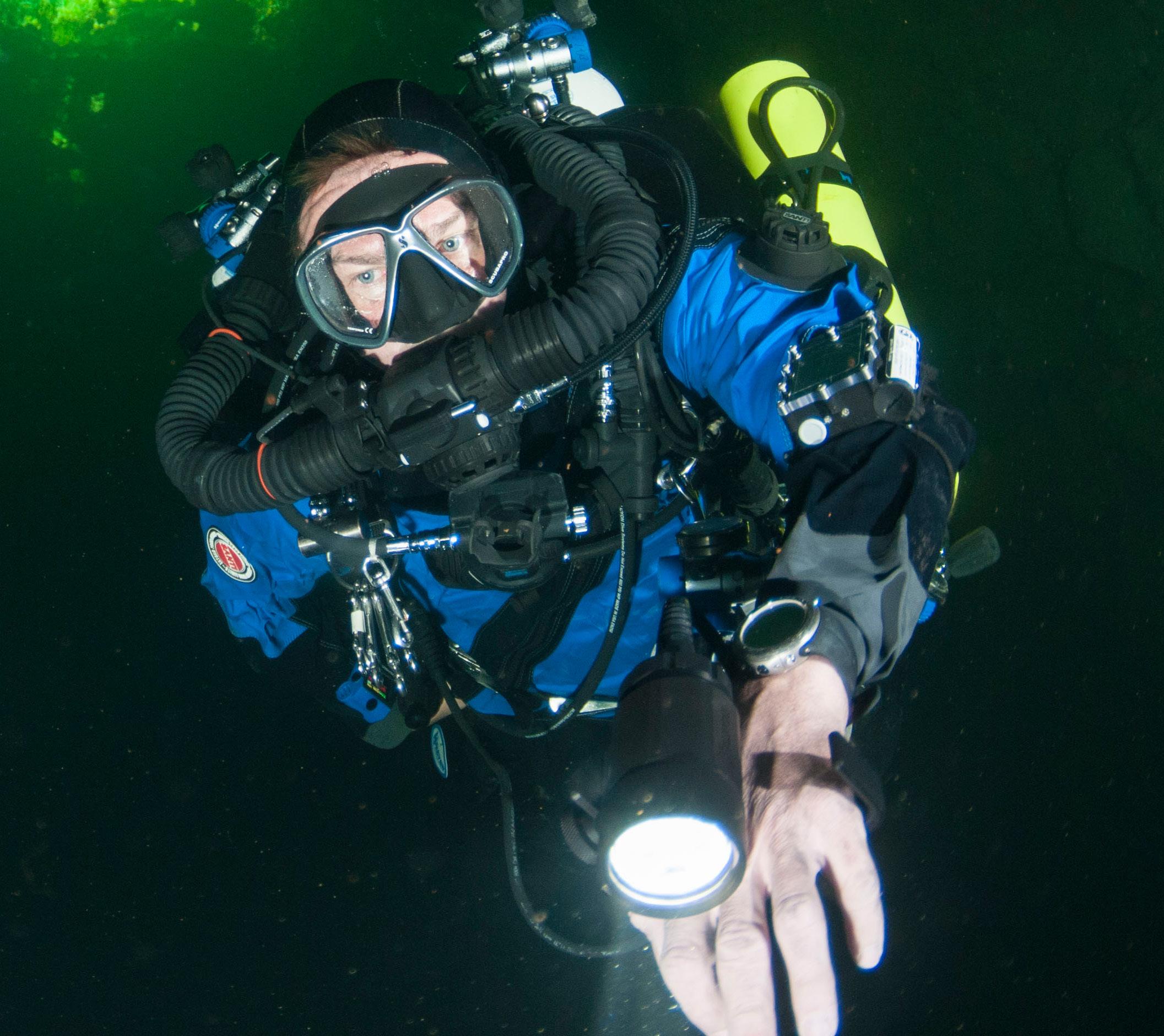
enjoys documenting those unique environments with cameras and various mapping tools, which have enabled him to contribute to several Project Baseline projects. Before starting to work at GUE, Andreas worked as a software development consultant in Sweden. He now resides in North Florida with his wife and daughter.
 Andreas Hagberg
Jarrod Jablonski on a JJ-CCR in Stargate cave, Bahamas.
Andreas Hagberg
Jarrod Jablonski on a JJ-CCR in Stargate cave, Bahamas.
51 February 2023 · Quest
PHOTOS ANDREAS HAGBERG
CAVE DIVING NAVIGATION & TECHNIQUE
Cave diving is a surprisingly safe activity when done properly and with the right amount of training, practice, and skills.
Caves offer more predictable and stable milieus without a lot of the environmental variables associated with diving in the ocean. But, going into a cave lacking solid navigation skills and proper diving techniques can quickly change the situation from benign to dangerous. Let’s review cave navigation protocols and define what we mean when we talk about good technique in cave diving.
TEXT FROM THE GUE PUBLICATION DEEP INTO CAVE DIVING WITH CONTRIBUTIONS FROM KIRILL EGOROV, JARROD JABLONSKI, DANIEL RIORDAN, FRED DEVOS, TODD KINCAID, & CHRIS LE MAILLOT PHOTOS KIRILL EGOROV & CLAUDIO PROVENZANI
52 Quest· February 2023
Divers must be extremely careful when using arrows to mark navigational decisions.

53 February 2023 · Quest
PHOTO KIRILL EGOROV
cave diving has evolved, so have the methods used to mark the line—a critical navigational aid. In the early years, divers used items such as colored ribbons and duct tape tabs to mark the exit. Some divers even marked the line with different-sized knots to reference the exit. Today, the most common marker is the line arrow: an isosceles triangle that should point in the direction of the exit. The line arrow is popular because it can be easily affixed to the line, remains securely attached where it is placed, and, even in zero visibility, clearly marks the direction of the exit.

Divers also use non-directional markers on the line. Originally, these markers were clothespins, but this type of marker has proved to be unstable, can easily fall from the line, or can be accidentally moved. Today, “cookies” are a more common non-directional marker. This circular shape provides a secure way for divers to mark their position with information relevant to their team but avoids the potential confusion for other dive teams with misleading directional arrows.
Navigating multiple exits
Multiple exits can increase the complexity of a dive and lead to confusion. When diving in a cave system with multiple exits, it is important that divers remain individually cognizant of the exit and never rely on line marker placement.
For instance, though line arrows should always point in the direction of the nearest exit, sometimes this exit is not the one sought by a given team. This is because the nearest exit may not be the one the team used to enter the cave system or the one that guarantees a continuous guideline out of the cave system. In fact, the marked exit might require divers to navigate beyond multiple gaps in the line to reach the intended exit. Inexperienced cave divers should limit their dives to simple penetrations and avoid the potential confusion of multiple exits.
This circumstance highlights the utility of non-directional markers. A team may place a
Ascookie on the exit side of a T, indicating their exit direction without confusing the exit for other dive teams.
Traverse
A traverse entails entering from one site and exiting at another distinctly different site. For example, divers can enter a cave through one sinkhole, travel through a cave passage, and exit at another location (usually another sinkhole).
Given that a traverse involves more than one entrance, and that divers may enter from either site, line marker placement and/or the shortest exit route can cause confusion. During a traverse, cave divers entering from a spring or sinkhole and continuing in the direction of another sinkhole may find that the line arrows will start to point away from their exit direction. This happens because, as a diver reaches the midpoint between the two exits, line arrows will generally begin to point toward whichever exit is closer. In other words, caves with multiple exits usually have arrows that reverse at the halfway point.
New divers should understand that an arrow pointing into the cave may be the result of several factors. It may indeed be that the diver has reached a halfway point between two exits; however, it could also be that the arrow was incorrectly installed, or even installed by a team diving from another entrance. Therefore, dive teams should never rely on markers placed by other divers, as these can provide incorrect information. Even if divers feel convinced that certain line arrows represent the true midpoint between two exits, they should terminate their dive upon reaching their one-third limit. Even though a team may be able to reach the end of the line during a traverse from one sinkhole to another (indicating that the second entrance is nearby), there is no guarantee that they can get to the open water from this new position.
Without a guideline installed to the open water, they may be unable to locate the surface. If divers violate thirds in order to reach this second exit but are unable to locate the surface, they may not have sufficient gas to manage a return trip. A dive in which a dive team relies on secondhand information to complete a traverse, and violates their gas rules to do so, is one that
54 Quest· February 2023
A permanent intersection, well-marked with arrows in Peacock Springs, Florida (USA).

55 February 2023 · Quest
PHOTO KIRILL EGOROV
flirts with disaster. Information about negotiating these restrictions can be found in the Dive Planning article later in the series.
Bridging the gap
When a guideline intersects with another exit, such as a sinkhole, the line will generally stop prior to reaching the daylight zone. Permanent lines may not run through basins because they can encourage open water divers to enter the cave.
In this case, the properly trained cave diver would install a temporary line that would join the two ends of the line. Bridging the distance between the ends of two lines is called a gap. This separation between permanent lines introduced by sinkholes is another of the associated risks relevant to multiple exits. As mentioned above, divers can become lost very close to the exit and may be unable to find their way to the open water.
Indeed, permanent line placement designed to discourage untrained divers from entering the
cave has been responsible for stranding careless cave divers several hundred feet from the exit, unable to find their way out. In this regard, it is often a difficult task to balance the desire to protect people from themselves with the need to simplify cave navigation. Regardless of divers’ personal views on this matter, in the end, cave divers are individually responsible not only for their own navigation in potentially difficult regions but also for their dive practice as a whole; they should always dive comfortably within their limits.
Spring flow
Caves vary considerably with respect to general structure, flow conditions, and sediments. While all of these factors can impact diver safety and comfort, variations in spring flow can require careful planning.
Spring flow can complicate a number of elements: gas management, exertion, stress, travel time, visibility, and scooter burn time. For example, divers entering a cave where water
 A diver glides through a halocline in a beautifully decorated Mexican cave.
PHOTO CLAUDIO PROVENZANI
A diver glides through a halocline in a beautifully decorated Mexican cave.
PHOTO CLAUDIO PROVENZANI
56 Quest· February 2023
outflow is strong will find that penetration will be more difficult and will require additional time and energy. In turn, spring outflow will facilitate a quick exit with reduced gas consumption and less effort required.
Conversely, a siphon (water flows into the cave) will facilitate diver penetration but will require greater effort and gas consumption to exit. In diving siphons, normal gas rules are inadequate and are replaced by guidelines that are designed to reduce the risk of such dives. Nonetheless, it is important to bear in mind that many of these rules are somewhat arbitrary and of limited benefit. Only very advanced divers should dive into siphons, as inflowing water can both complicate dive planning and compromise team safety.
Similar problems can surface when diving in areas with multiple exits, even without diver awareness of the associated risks. For example, divers undertaking a traverse in caves with notable flow will be subject to outflow (spring) conditions when entering from one entrance and to inflow (siphon) conditions when entering

from the other. Therefore, divers planning to establish a connection and dive a traverse would find themselves obligated to two different sets of gas management rules and to a range of potential complications. Generally speaking, when diving in areas with multiple exits, teams should travel against the current to avoid dangerous siphons and complicated gas rules.
Siphons
Though there are no hard-and-fast gas rules with respect to diving siphons, doing so nonetheless requires dive teams to reserve a greater quantity of available gas.
It is difficult to establish credible gas rules for diving siphons since flow conditions vary from one cave to the next. Historically, individuals have recommended using no more than 1/6 of their gas supply (as opposed to 1/3) when penetrating siphons. However, such a rule is arbitrary, as it does not allow for the variability of conditions nor to the different levels of spring flow.
Such recommendations should only be taken by divers as generic starting points,
While working on a project, you may need project-specific equipment (scale bars, measuring tapes, etc.).
PHOTO CLAUDIO PROVENZANI
57 February 2023 · Quest
DPVs are a great tool in cave diving but should never be used without the proper training and preparation.

“Divers must evaluate similar and even more complex practices when considering the use of a DPV in a siphoning cave.
58 Quest· February 2023
PHOTO KIRILL EGOROV
and divers should remain aware that, in most cases, gas rules of this kind will be modified as one’s dive experience and familiarity with equipment grows. In diving siphons, assessing one’s required gas supply is mostly an experience-based skill acquired over multiple shortrange diving ventures. Divers can undertake limited penetrations while using conservative gas management rules (such as the 1/6 rule) while they gain an appreciation for the amount of time and gas necessary to exit against the siphoning flow.
Divers must evaluate similar and even more complex practices when considering the use of a DPV in a siphoning cave. Of course, divers must be able to exit the cave in the event of a DPV failure. Additional considerations for diving siphons include placing safety bottles (bottles left for emergencies) and diving with additional DPVs that can be used in the event of an equipment failure. More complete information on planning dives of this nature is available in the Dive Planning article in this series.
Technique
Poor diving technique not only greatly increases divers’ stress but also reduces divers’ ability to manage emergency situations. Most emergencies are the cumulative effect of a series of trivial problems—usually issues resulting from poor diving technique and/or situational awareness. Divers with good buoyancy, proper trim, and an efficient equipment configuration are far less prone to unnecessary stress. These divers are also much better prepared to manage diving problems.
The words trim and buoyancy are sometimes used incorrectly to mean the same thing. Though related, these skills are two different elements of efficient diving, each requiring practice to master. Buoyancy refers to a diver’s ability to maintain a neutral position in the water while adjusting to weighting variations that result from changes introduced by gas consumption and compression of thermal insulation. Proper trim refers to a diver’s position (ideally somewhere near horizontal) in the water relative to the bottom. Once divers learn to balance trim and buoyancy, they will find that their swimming
efforts and gas consumption will decrease, making their dives easier, more efficient, safer, and much more fun.
Good buoyancy control is a key aspect of any form of diving, but it is especially important in cave diving. Swimming in silt-laden areas with rock obstructions above divers’ heads requires finely-tuned buoyancy skills. Just as important, if not more so, is divers’ trim. Divers swimming along in a cave should be horizontal to the bottom so as to minimize the potential for stirring up sediments.
Poor trim would indicate that divers are not horizontal and that some part of their body (usually feet or knees) is either contacting the bottom or directing water toward the sediments. While good buoyancy control is usually indicative of divers’ levels of experience in the water, proper trim marks a mastery of diving efficiency.
Weighting
Divers demonstrating good trim move through the water in a horizontal position with their feet slightly elevated. Most divers (incorrectly) swim in a feet-down position using a kick that generates a downward thrust. This increases the surface area of the body seeking to move through the water as well as the energy required to propel it forward. This posture also directs additional thrust from divers’ fins toward the bottom, potentially disturbing sediment and reducing visibility. Swimming with poor trim can lead to reduced efficiency, increased effort, bad visibility from disturbed sediments, and a damaged diving environment. Therefore, proper trim can be an asset for good cave divers, but improper trim can cause issues that should be of concern for divers in any underwater environment.
Certain buoyancy compensator (BC) designs can actually impede divers’ abilities to achieve proper trim. For example, BCs with restrictive bands can promote gas trapping and increase drag by generating turbulent flow around the diver. Trapped gas pockets can create unequal pockets of lift, throwing divers off balance. Furthermore, traditional jacket-style BCs generally lift the upper portion of the body, forcing the legs downward and making it even more difficult to remain horizontal. Though prac-
59 February 2023 · Quest
ticed divers may be able to overcome this shortcoming, back-mounted BCs facilitate proper trim.
Conventional open water weighting systems—by positioning the bulk of a diver’s weight around the waist—tend to promote a feet-down swimming position and impact proper trim. Cave divers usually avoid this by wearing heavier double tanks. However, all divers (including recreational) would benefit from redistributing this weight and establishing proper trim. Divers can accomplish this by using a steel backplate, a weight behind the backplate (such as a V-weight for doubles), or a weight on the back of a single tank. Steel cylinders can also help divers limit the need for additional weight.

Clearly, divers need sufficient weight to maintain continuous submersion below the surface despite changes in buoyancy (initiated by factors such as gas consumption). Divers must also avoid over-weighting themselves, which is a far more common problem.
It is very important that divers evaluate their buoyancy to ensure that they are properly weighted. When properly weighted, divers should be able to hold their position in the water at 3 m/10 ft (for safety/decompression purposes) with nearly empty tanks. If under-weighted, divers could float to the surface in the event that an equipment failure caused a complete gas loss; if over-weighted, they would need more gas in their BCs, thereby increasing both their drag and the energy required to propel them forward. The effort of struggling against improper weighting alone can create enough stress to trigger an emergency.
It is difficult to exaggerate the value of proper weighting, good buoyancy control, and fine trim. In most cases, weaknesses in these areas go largely ignored but contribute to considerable levels of discomfort and stress. Failure to address these areas can easily be said to have led to countless accidents. Divers should seek to master these fundamentals and to maintain a close watch on anything that may impact them. Other excellent methods for improvement include asking others for critical advice and having another diver videotape their in-water performance.
Next time: Cave propulsion
“
It is difficult to exaggerate value of proper weighting, good buoyancy control, fine trim. In most cases, weaknesses in these areas largely ignored but contribute to considerable levels of discomfort and stress.
60 Quest· February 2023
exaggerate the weighting, and cases, areas go contribute of
Precise and slow communications are key to team comfort and efficiency.

61 February 2023 · Quest
PHOTO KIRILL EGOROV
COMPUTERS & TIMERS
GUE has long been skeptical of dive computers. In most cases, these reservations have been justly deserved— computers have historically produced ill-conceived and sometimes potentially dangerous profiles. Inconsistent reliability was also a common problem for many years. More recently, the technical capacity and reliability of dive computers have greatly improved, and today’s decompression computers can very closely approximate current GUE diving protocols.
Historically, GUE divers were reluctant to embrace dive computers; the devices were imperfectly designed, and divers’ blind trust in them (despite their inconsistency and undesirable decompression algorithms) was unsettling. Modern-day computers, however, have become more reliable and, to a reasonable extent, have incorporated improved decompression algorithms.
The devices still aren’t perfect, and their overall increased reliability has potentially made the impacts of the remaining malfunctions even more severe. After just a few positive experiences using them, divers could become more reliant upon their computers and grow complacent. Because of this, GUE allows divers to use computers as a backup but adamantly discour-
ages using these devices without first understanding how to dive without them. GUE courses continue to teach important decompression techniques that give divers a full grasp of the concepts, which lets divers remain entirely independent of any decompression computer.
Many divers choose to run their computer in gauge mode (displaying just time and depth) to use it as a bottom timer. Instruments with clearly readable screens are the norm.
Bottom timers
If all you need is an accurate indication of depth and time, a bottom timer can do the trick. With accurate depth and run time information, divers can calculate the proper decompression obligation if required. Digital gauges with large displays are preferable, and interfaces should be easily readable in low light conditions. An easily
– Essentials
of the GUE equipment configuration
TEXT DIMITRIOS FIFIS PHOTOS JULIAN MŰHLENHAUS, DERK REMMERS & KIRILL EGOROV
62 Quest· February 2023
Modern dive computers have large, easy-to-read displays and many useful functions, such as digital compasses and resettable average depth.
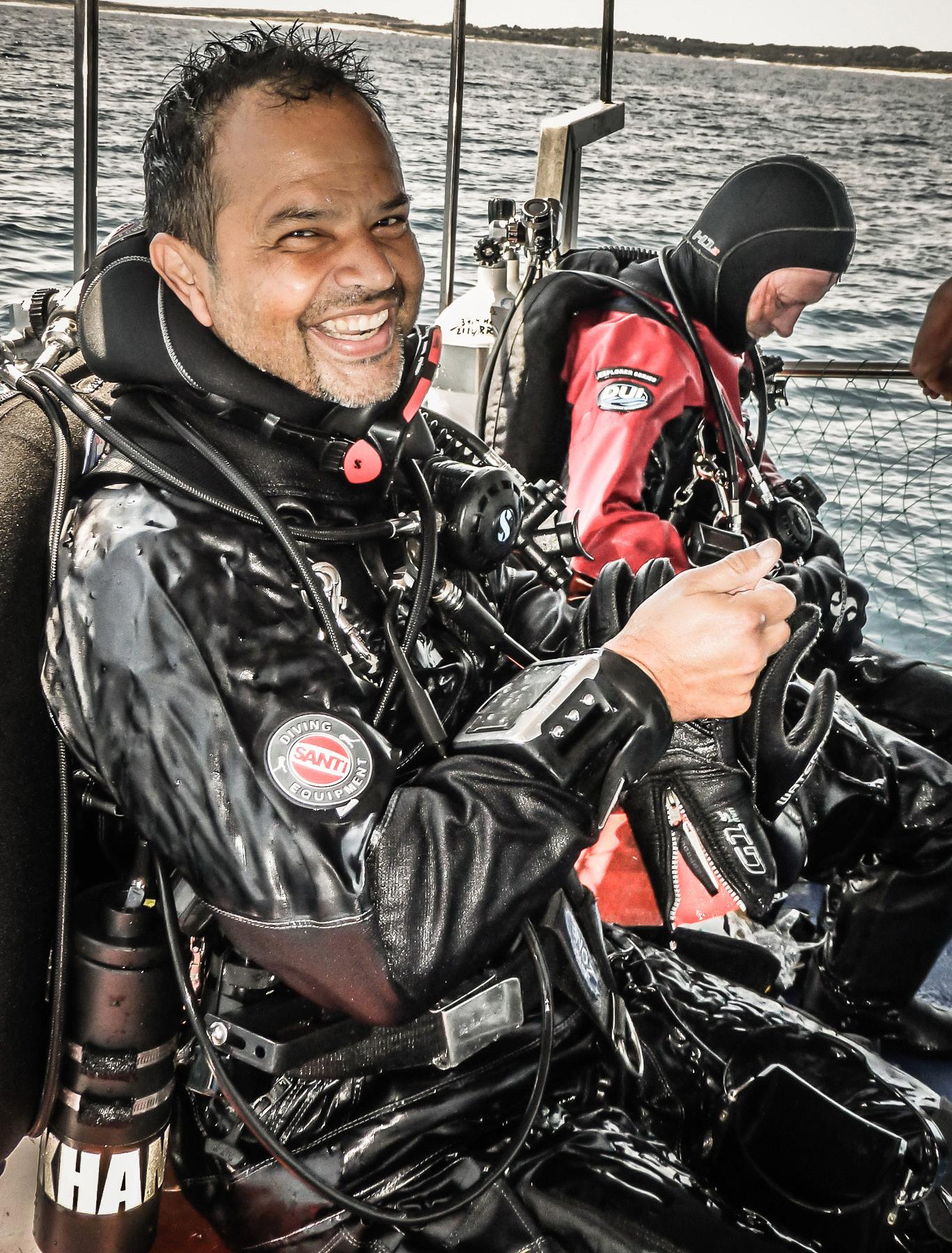
63 February 2023 · Quest
PHOTO DERK REMMERS
GUE divers always wear the primary instrument on the right wrist, which can be illuminated with a light held in the left hand if necessary.

64 Quest· February 2023
PHOTO KIRILL EGOROV
understood, minimalist interface is also ideal, but a stopwatch function is a useful additional feature. The instrument should be attached to your right wrist so that you can illuminate it with your primary light (held in your left hand) while operating a diver propulsion vehicle (DPV).

There are numerous excellent bottom timers available on the market today, and most computers can be used in gauge mode and exclusively function as a bottom timer. Many action watches or smart watches (including Apple Ultra) also give time and depth, secondary information (like temperature), and additional functions (like logging).
Tables
While breathing underwater, gas accumulates in a diver’s tissues. The volume of gas absorbed and the way it is removed are complex interactions involving a range of variables—most of which are related to the time spent at a given depth. Decompression modeling attempts to capture these variables by using algorithms that anticipate gas accumulation at a given gas mixture, a specific depth, and over a particular time period. Decompression tables provide a simplified way to track this process, but for the sake of simplicity, they round time and depth into categories that sometimes create fairly conservative decompression estimates. While divers have been using these tables successfully for years, they have done so by accepting limitations that—for the most part—make dives shorter or require longer decompression profiles. These limitations were created primarily by a lack of precision in assessing time at various
throughout a profile. For example, while a diver might spend only a few minutes at the deepest depth, the tables may show the entire profile at this depth.
Compelling features
When dive computers were introduced and their early reliability problems were solved, they slowly became a preferred decompression management strategy for most divers. They provided divers a device that could closely monitor depth-time profile and calculate in real time, allowing more precise calculations for a given profile. Manufacturers offered a variety of products. Most of the earliest models had no customization options, and they produced quite conservative—and sometimes oddly shaped— decompression profiles. Despite these issues, most divers migrated to using computers. The convenience, ease of use, and real-time monitoring were compelling features.
Blind followers
With these advantages came a new problem. Divers became complacent, trusting the output from computers and paying little attention to their own awareness of their current decompression status—and ignoring the tactics they learned in training. Divers gradually began to disregard decompression planning. At the same time, traditional training agencies and instructors de-emphasized the importance of using diving tables and even the need to under-
65 February 2023 · Quest
Choose a computer model with the same algorithm as GUE’s DecoPlanner (Bühlmann ZHL16) and customizable conservatism such as gradient factors.
and agree on the plan with your team. If you agree to follow your dive computer’s recommendation, be sure it mirrors your pre-planned expectations and that the team agrees with this strategy.
your
stand the nuances of decompression science. In other words, divers started to blindly follow a number on a screen without developing a fundamental understanding of what that number represented, its origin, or how it could change during a dive. Furthermore, different brands and models followed different decompression algorithms, produced different versions of the same algorithm, and offered different results for the same depth and dive profile. This complicated team operations and led to confusion.
Desktop software
The lack of flexibility, concerns over reliability, inefficient decompression profiles, and differing profiles in the team—among other factors—were major influences in GUE’s reluctance to embrace dive computers as their primary means of decompression planning and monitoring. GUE instead chose to use desktop decompression software as the
primary method of decompression planning. This allowed the creation of standardized deco strategies that could be tailored to the dive plan’s specific variables, including the type of dive, experience of the team, profile of the environment, and various other contingencies.
Fortunately, dive computer technology is evolving, and current models offer similar advantages to those sought in desktop technologies. These computers allow the user a reasonable level of customization, offering them the chance to model GUE’s tailored ascent—this means that they can produce similarly successful results to GUE’s DecoPlanner desktop decompression software. See page 42 in this issue of Quest for a full article on the past, present, and future of DecoPlanner.
Supporting role
Despite technological advances in dive computer technology, one critically important

“Adequately plan
dive
66 Quest· February 2023
PHOTOS JULIAN MŰHLENHAUS
consideration remains: Divers should not be overly reliant on dive computers, using them in a supporting capacity to augment knowledge and planning. Blindly following a computer is irresponsible and can be dangerous.
All GUE divers should consider the following recommendations when using dive computers. Choose a computer model that uses the same algorithm as GUE’s DecoPlanner (Bühlmann ZHL16), which has a customizable conservatism factor (preferably gradient factors). This way, your dive profile (MDLs, decompression obligations, and variable ascent rates) will closely match the planning you can do with desktop software or a smart phone app. This enhances flexibility, supports dive planning, and helps maintain team coherence.
Choose a computer model that offers a resettable average depth indicator function as well as a timer. This will allow you to accurately monitor your average depth and easily compare the computer suggestion with expecta-
tions set during dive planning. It will also help to maintain GUE standard protocols, such as pragmatic MDL.
Adequately plan your dive and agree on the plan with your team. If you agree to follow your dive computer’s recommendation, be sure it mirrors your pre-planned expectations and that the team agrees with this strategy.

Always follow the GUE ascent profile, even if you are using a computer to calculate MDL or decompression obligations. Consistent implementation of GUE’s standard ascent profile supports better ascent control, allows time for ascent-related tasks (e.g., SMB, primary light stowage, and team communication), and is consistent with ascent practices followed in more advanced types of diving. Your dive computer monitors your ascent rate and takes into consideration any additional time spent during the ascent.
Take control
Do not reduce your level of situational awareness. Dive computers can’t predict the future— always remain aware of the environment and the team. Diving while blindly following a dive computer often results in a false feeling of safety. Many dive computers offer a TTS (Time to Surface) calculation, but you should keep in mind that this calculation does not account for factors such as cold, current, and equipment malfunctions which can affect the dive plan and your decompression profile.
Remember that dive computers can perform calculations quickly, and they can offer accurate suggestions, but they can’t make decisions. The diver needs to make the decision, and for this, you need enough knowledge about both diving concepts and your device. Make sure you understand the concepts of gas absorption, gas elimination, and basic decompression theory; discuss any questions you have with a GUE instructor.
If your particular computer model has a deep stop function implemented, it is recommended you disable it when following a GUE ascent profile. A GUE ascent profile already incorporates strategies for addressing bubble formation and reduction of asymptomatic bubbles.
For technical dives involving gas switching, multi-gas computers can be used to track decompression.
67 February 2023 · Quest
Use DecoPlanner
Read the manual and understand the functions of your dive computer before using it. Take the time to set the computer properly and input all necessary data: conservatism levels, gas used (travel, bottom, and decompression gases), last stop depths, salt or freshwater, when the computer will start to count time of a surface interval, and when it will start to count dive time. Learn your computer progressively. Do not rely on it while using it for the first time or on a difficult, challenging dive. Become familiar with how it behaves—which information it indicates and how it’s displayed. It will require awareness and concentration to understand the information the device is displaying, at least during the first few dives.
When multi-day diving, like on a liveaboard, use GUE DecoPlanner as your primary planning tool, using your dive computer as a backup verification tool. This strategy offers the best of both worlds—you benefit from the value and
flexibility of standard protocols as well as the precise data collection capacity of a dive computer. Pragmatic or other planning tools have limitations, especially over extended diving events, and your computer can mitigate these risks.
Ensure all team members use the same settings on their computers. Do not allow a dive-computer-generated profile to separate the team.
Another layer of safety
When used by properly trained, thinking divers, dive computers can simplify decompression tracking and provide another layer of safety for the team. All divers should strive to understand and learn about the latest decompression theory and always use sound diving practices and protocols, no matter which tools they choose for underwater support.
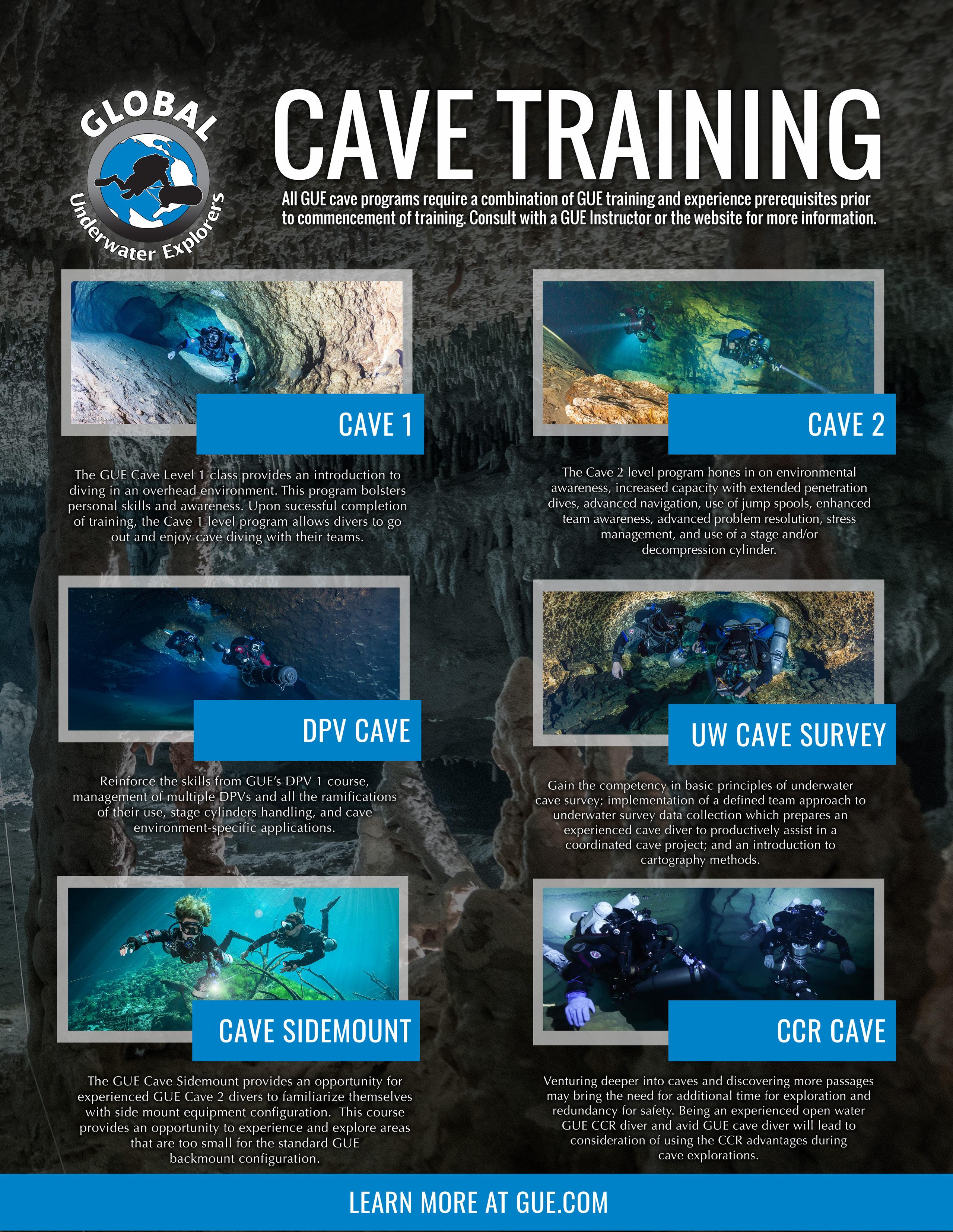
Next time: stage/deco cylinders
Dimitris Fifis
Born in Athens, Greece, Dimitris Fifis started diving in 1991 and became an instructor in 1998. In 2009, after 23 years of service in the Greek Navy (most of them in the aviation branch), he retired and decided to pursue a fulltime career in diving. Since then he has managed diving operations in various diving centers in Greece as well as on mega-yachts. Dimitris discovered GUE
in 2007 and never looked back. He currently lives and works in Dubai, and is involved in various wreck exploration and underwater filming projects in the area. Because of his strong interest in increasing dive safety through quality education, he also produces training videos for GUE.

68 Quest· February 2023
“Ensure all team members use the same settings on their computers. Do not allow a dive-computer-generated profile to separate the team.

GUE PREMIUM DIVE CENTERS
Base1 – Sardinia, Italy

www.baseone.it
Deep Dive Dubai – Dubai, UAE
www.deepdivedubai.com
Dive Centre Bondi – Bondi, NSW, Australia

www.divebondi.com.au
Duikcentrum de Aalscholvers – Tilburg, Netherlands
www.aalscholvers.nl
Eight Diving – Des Moines, WA, USA
www.8diving.com
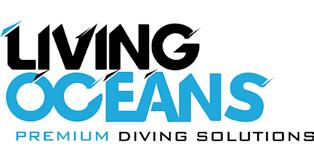
Exploration Diver – Hangzhou, China
www.facebook.com/qiandaolake
Extreme Exposure – High Springs, FL, USA
www.extreme-exposure.com
Islas Hormigas – Cabo de Palos, Spain
www.islashormigas.com

Living Oceans – Singapore
www.livingoceans.com.sg
Plongée Nautilus – Quebec City, QC, Canada

www.plongeenautilus.com
Scuba Academie – Vinkeveen, Netherlands
www.scuba-academie.nl
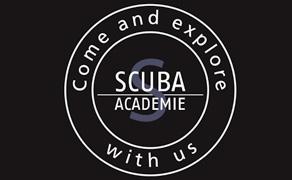

Tec Diving – Luzern, Switzerland
www.tecdiving.ch

70 Quest· February 2023
Tech Korea – Incheon, South Korea

www.divetechkorea.com


Third Dimension Diving – Tulum, Q. Roo, Mexico
www.thirddimensiondiving.com
Zen Dive Co – Los Angeles, USA
www.zendive.com

Zero Gravity – Quintana Roo, Mexico
www.zerogravity.com.mx
T H I R D DIME N S IONDIV N G TULUM MÉXICO
PREMIUM DIVE CENTER 2023 71 February 2023 · Quest
GUE DIVE CENTERS
Buddy Dive Resort – Bonaire

www.buddydive.com

Dive Alaska – Anchorage, AK, USA
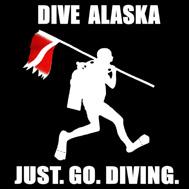
www.divealaska.net
Diveolution – Kessl-Lo, Belgium
www.diveolution.com
Emperor Divers – Sharm el Sheikh, Egypt

www.emperordivers.com

Faszination-Tauchsport – Sauerlach, Germany
www.faszination-tauchsport.de

Innovative Divers – Bangkok, Thailand
www.facebook.com/innovativedivers

KrakenDive – Tossa de Mar, Spain
www.krakendive.com
Paragon Dive Group – Arizona, USA
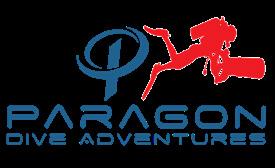
www.paragondivestore.com
Living Oceans Malaysia – Kuala Lumpur, Malaysia

www.livingoceans.com.my
Scuba Adventures – Plano, TX, USA
www.scubaadventures.com

72 Quest· February 2023
Scuba Seekers – Dahab, Egypt
www.scubaseekers.com


Tauchservice Münster – Münster, Germany
www.tauchservice.info

Tech Asia – Puerto Galera, Philippines

www.techasia.ph

DIVE CENTER 2023 73 February 2023 · Quest














 TEXT BRAD BESKIN
PHOTO SJ ALICE BENNETT
TEXT BRAD BESKIN
PHOTO SJ ALICE BENNETT














 Nils Lucas Jacobsen
Nils Lucas Jacobsen
 TEXT BJARNE KNUDSEN, EMŐKE WAGNER & LÁSZLÓ CSEH
TEXT BJARNE KNUDSEN, EMŐKE WAGNER & LÁSZLÓ CSEH


 PHOTO TOM ST GEORGE
PHOTO TOM ST GEORGE

 PHOTO TOM ST GEORGE
PHOTO TOM ST GEORGE










 László Cseh
Bjarne Knudsen
László Cseh
Bjarne Knudsen












 TEXT ANDREAS HAGBERG
PHOTOS ANDREAS HAGBERG & JESPER KJØLLER
TEXT ANDREAS HAGBERG
PHOTOS ANDREAS HAGBERG & JESPER KJØLLER





 PHOTO JONO ALLEN
PHOTO JONO ALLEN



 Andreas Hagberg
Jarrod Jablonski on a JJ-CCR in Stargate cave, Bahamas.
Andreas Hagberg
Jarrod Jablonski on a JJ-CCR in Stargate cave, Bahamas.



 A diver glides through a halocline in a beautifully decorated Mexican cave.
PHOTO CLAUDIO PROVENZANI
A diver glides through a halocline in a beautifully decorated Mexican cave.
PHOTO CLAUDIO PROVENZANI














































